Class 10 Maths Chapter 5 Arithmetic Progressions (English + Hindi) NCERT Solutions
- Ex.5.1
- Ex.5.2
- Ex.5.3
- Ex.5.4
- Arithmetic Progressions Class 10 Extra Questions
- Arithmetic Progressions Class 10 Important Questions
- Arithmetic Progressions Class 10 Notes
Page No: 99
Ex 5.1 Class 10 Maths Question 1.
In which of the following situations, does the list of numbers involved make an arithmetic progression and why?
(i) The taxi fare after each km when the fare is ₹ 15 for the first km and ₹ 8 for each additional km.
(ii) The amount of air present in a cylinder when a vacuum pump removes
(iii) The cost of digging a well after every meter of digging, when it costs ₹ 150 for the first meter and rises by ₹ 50 for each subsequent meter.
(iv) The amount of money in the account every year, when ₹ 10000 is deposited at compound interest at 8% per annum.
Solution: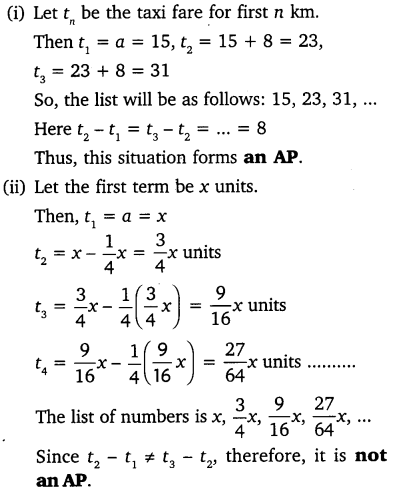
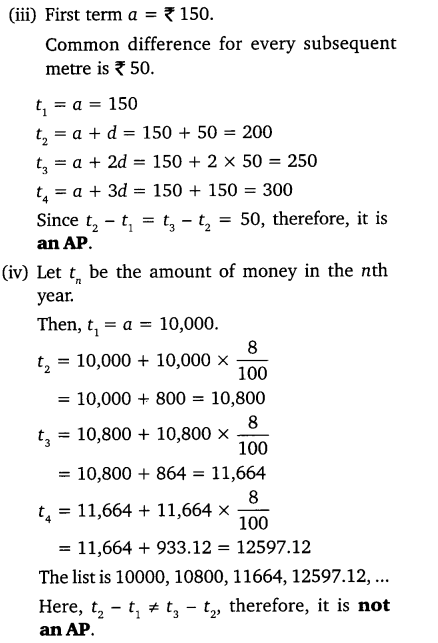
Ex 5.1 Class 10 Maths Question 2.
Write first four terms of the AP, when the first term a and the common difference d are given as follows:
(i) a = 10, d = 10
(ii) a = -2, d = 0
(iii) a = 4, d = -3
(iv) a = -1, d =
(v) a = -1.25, d = -0.25
Solution: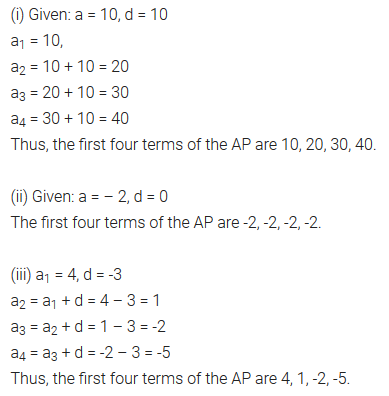
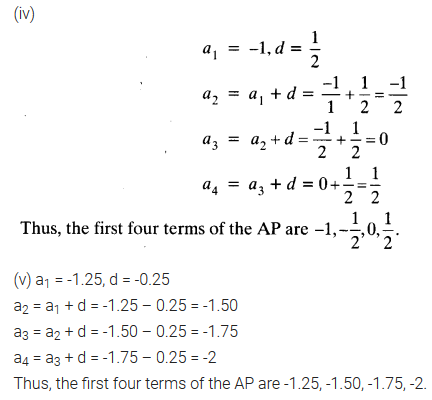
Ex 5.1 Class 10 Maths Question 3.
For the following APs, write the first term and the common difference:
(i) 3, 1, -1, -3, ……
(ii) -5, -1, 3, 7, ……
(iii)
(iv) 0.6, 1.7, 2.8, 3.9, …….
Solution: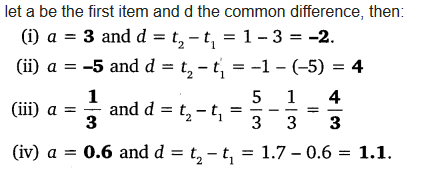
Ex 5.1 Class 10 Maths Question 4.
Which of the following are APs ? If they form an AP, find the common difference d and write three more terms.
(i) 2, 4, 8, 16, …….
(ii) 2,
(iii) -1.2, -3.2, -5.2, -7.2, ……
(iv) -10, -6, -2,2, …..
(v) 3, 3 +
(vi) 0.2, 0.22, 0.222, 0.2222, ……
(vii) 0, -4, -8, -12, …..
(viii)
(ix) 1, 3, 9, 27, …….
(x) a, 2a, 3a, 4a, …….
(xi) a, a2, a3, a4, …….
(xii)
(xiii)
(xiv) 12, 32, 52, 72, ……
(xv) 12, 52, 72, 73, ……
Solution: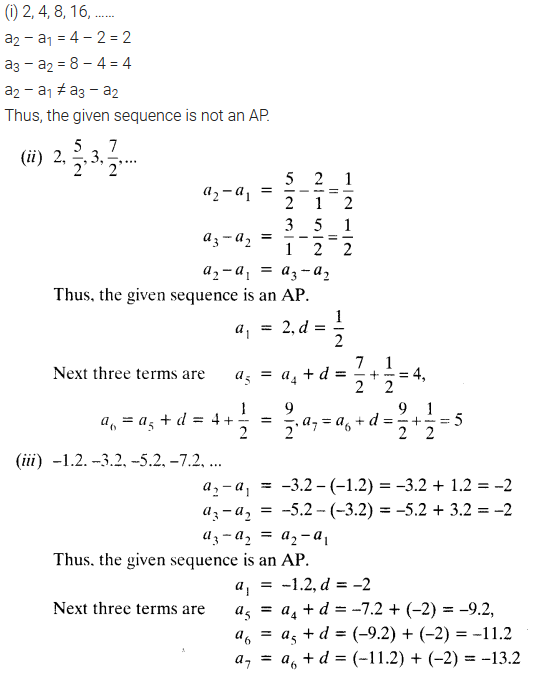
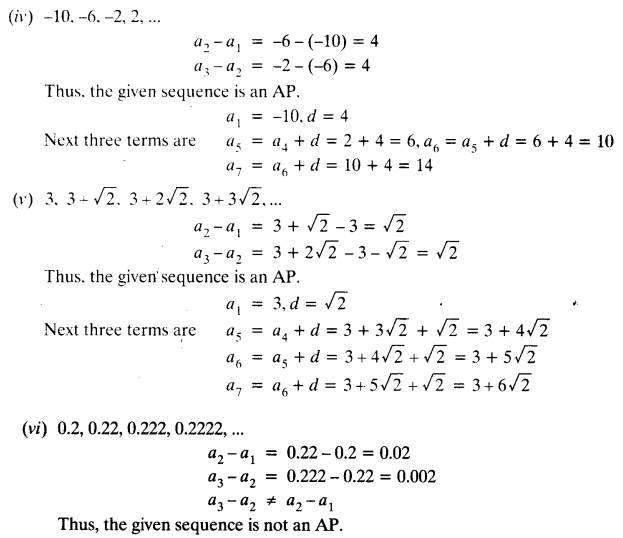
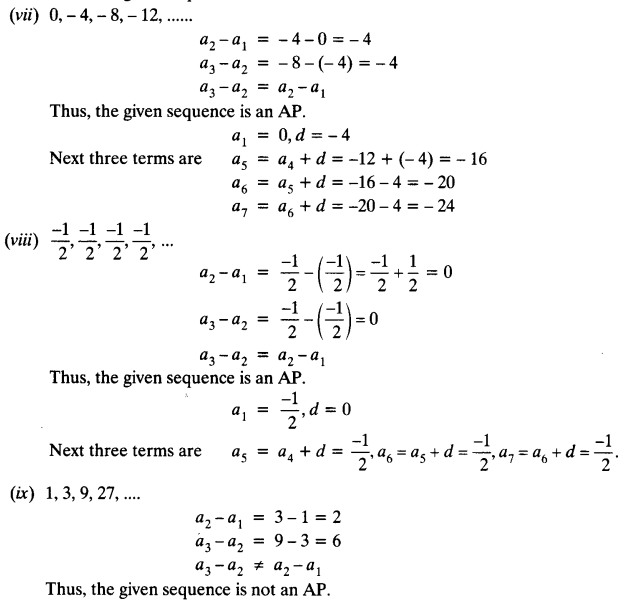
Class 10 Maths Arithmetic Progressions Mind Maps
Arithmetic Progression (AP)
Consider
(i) 1, 2, 3, 4, ……
(ii) 3, 3, 3, 3, …..
(i) and (ii) are the sequence of numbers, each number in these sequences is called a term.
An arithmetic progression (AP) is a sequence of numbers in which each term is obtained by adding a fixed number ‘d’ to the preceeding term, except the first term.
The fixed number is called the common difference. It can be positive, negative or zero.
Any Arithmetic progression can be represented as :
a, a + d, a + 2d, a + 3d,…..
where ‘a’ is the first term and ‘d’ is the common difference. Arithmetic progressions which does not have a last term are called Infinite Arithmetic Progression. e.g.:
6, 9, 12, 15,…….
Formula for common Difference (d)
A sequence of numbers a1, a2, a3…. is an AP if the difference a2 – a1, a3 – a2, a4 – a3…. gives the same value, i.e. if ak+1 – ak is the same for different values of k. The difference (ak+1 – ak) is called common difference (d). Here ak+1 and ak are the (k + 1)th and kth terms respectively.
∴ d = a2 – a1 = a3 – a2 = a4 – a3
nth Term (or General Term) of an Arithmetic Progressions
In an AP, with first term ‘a’ and common difference d, the nth term(or the general term) is given by,
an = a + (n – 1)d
Note that an AP can be finite or infinite according to as the number of terms are finite or infinite.
If there are m terms in an AP then am is the last term and is sometimes denoted by ‘l’.
Sum of the FIRST ‘n’ Terms of an A.P.
(i) The sum of the first n terms of an A.P. is given by![]()
where a is the first term and d is the common difference
(ii) If l is the last term of the finite A.P. say the nth term, then the sum of all terms of the A.P. is given by,
Note that sum of first n positive integers is given by
Arithmetic Mean Between Two Numbers
If a, b, c are in AP. Then b is called the arithmetic mean of a and c and is given by
CLASS 10 MATHS CHAPTER 5 EXERCISE 5.1 AP SOLUTIONS IN HINDI
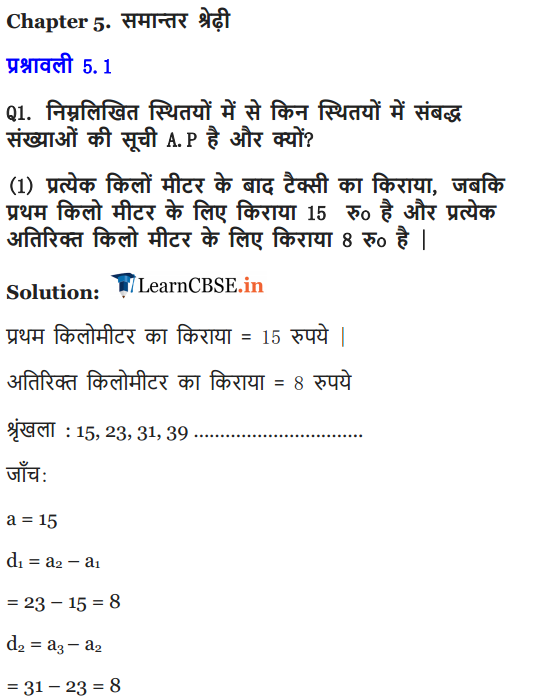
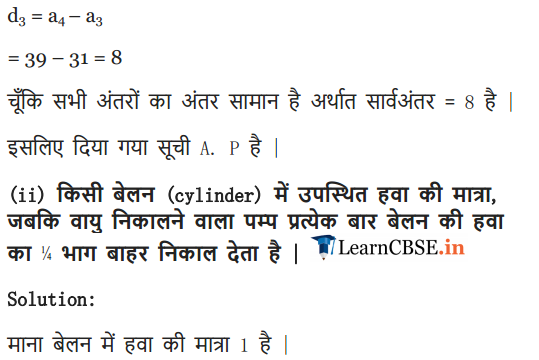
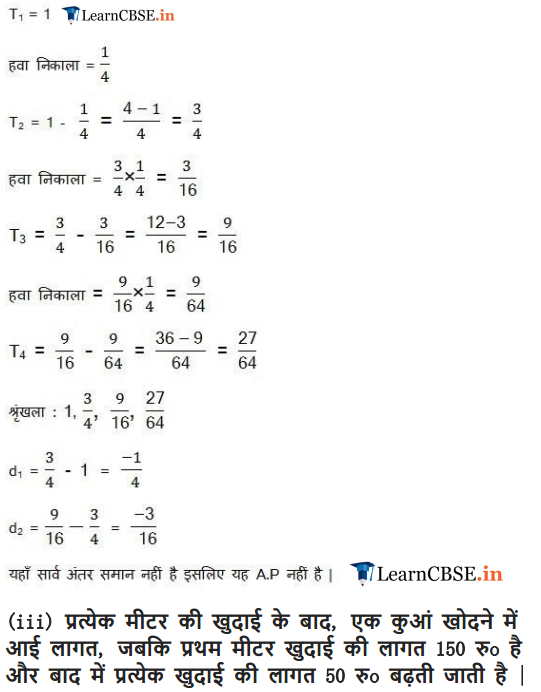
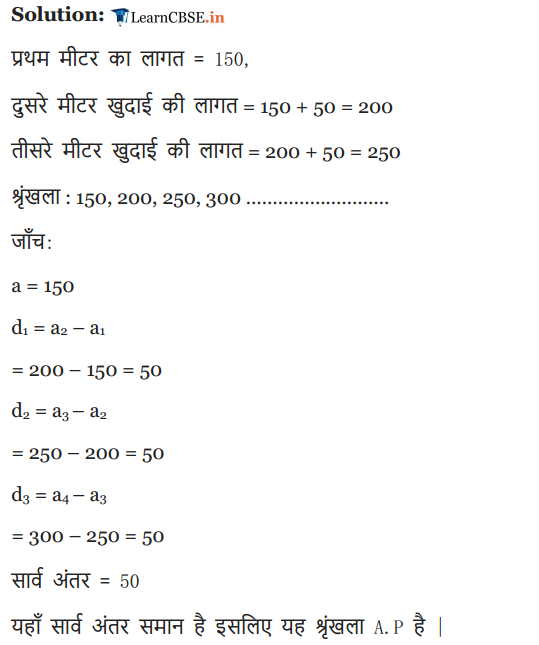
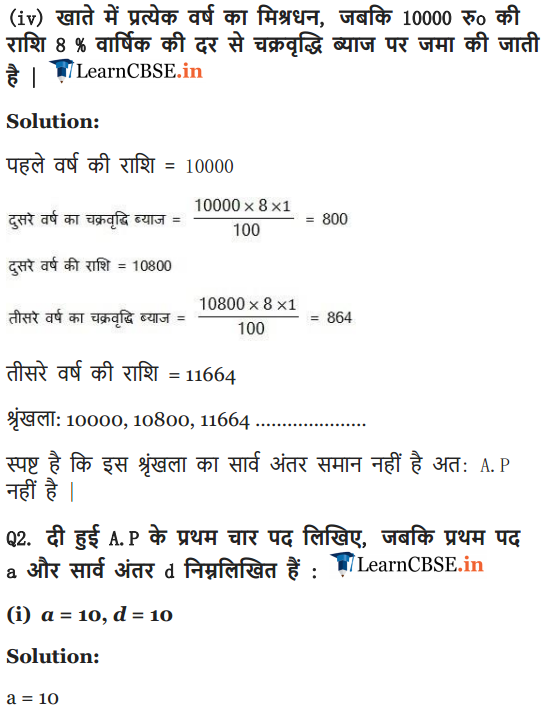
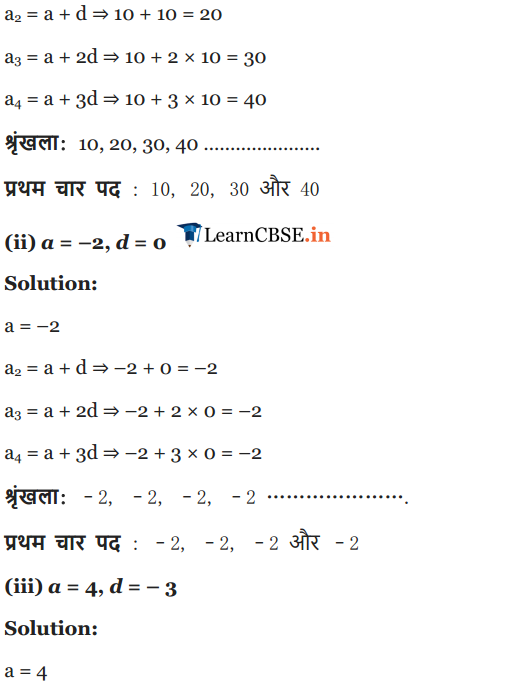
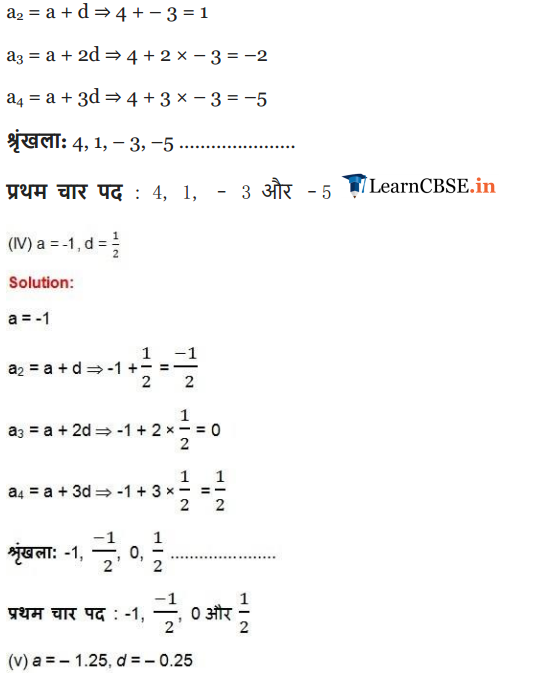
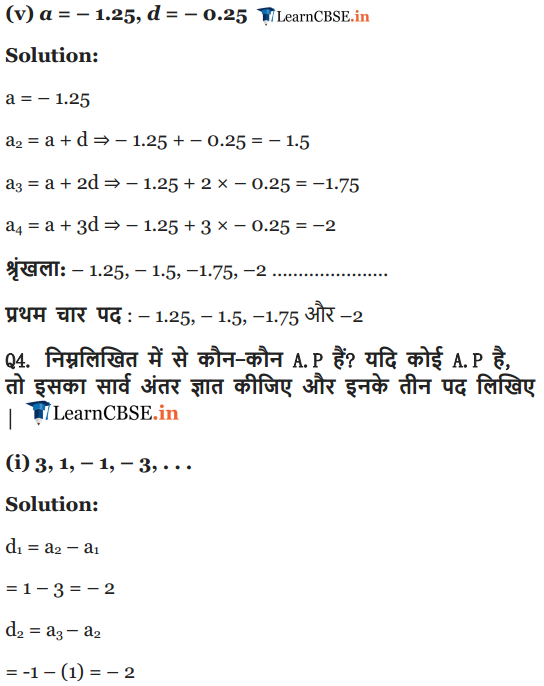
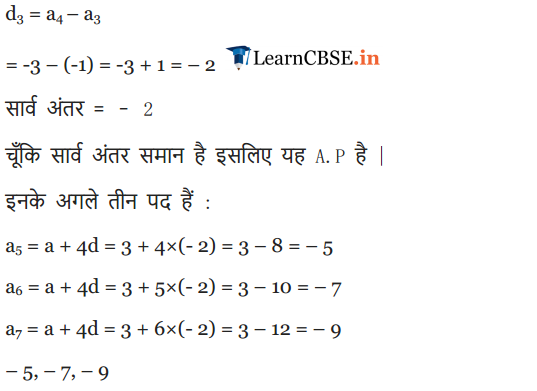
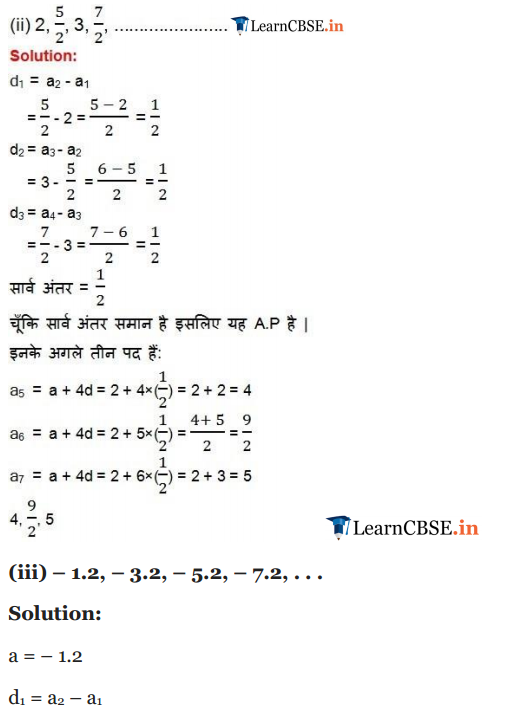
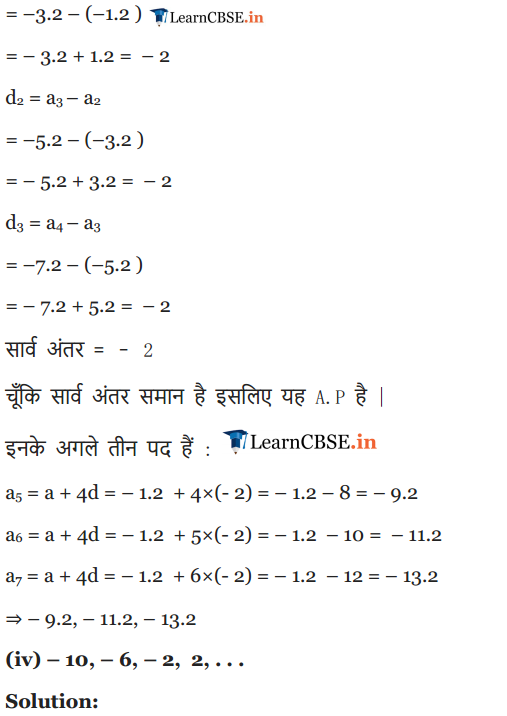
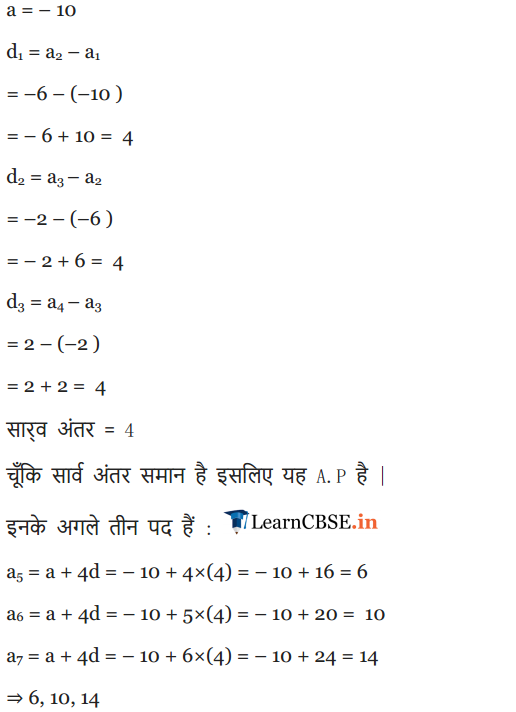
Class 10 Maths Chapter 5 Arithmetic Progressions Ex 5.2
Ex 5.2 Class 10 Maths Question 1.
Fill in the blanks in the following table, given that a is the first term, d the common difference and the nth term of the AP: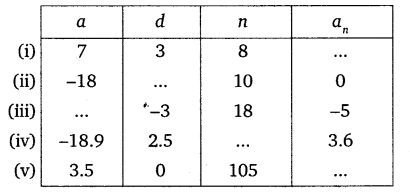
Solution: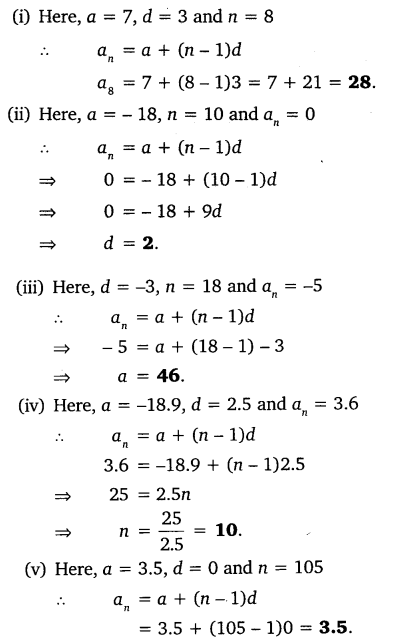
Ex 5.2 Class 10 Maths Question 2.
Choose the correct choice in the following and justify:
(i) 30th term of the AP: 10, 7, 4, …, is
(a) 97
(b) 77
(c) -77
(d) -87
(ii) 11th term of the AP: -3,
(a) 28
(b) 22
(c) -38
(d) -48
Solution: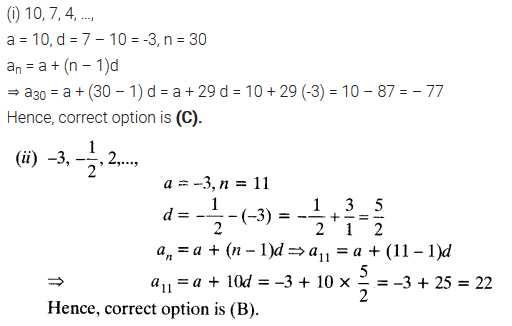
Download NCERT Solutions For Class 10 Maths Chapter 5 Arithmetic Progressions PDF
Ex 5.2 Class 10 Maths Question 3.
In the following APs, find the missing terms in the boxes:
Solution: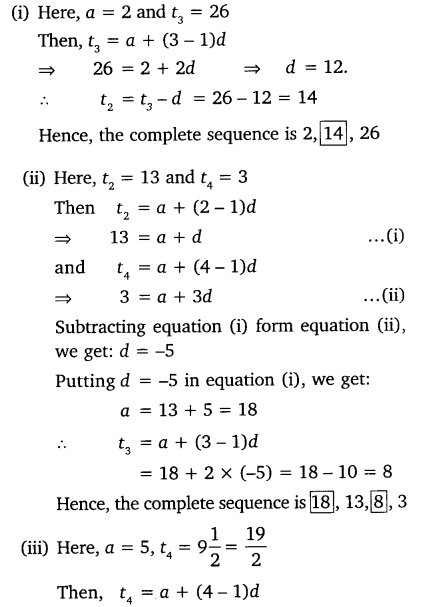
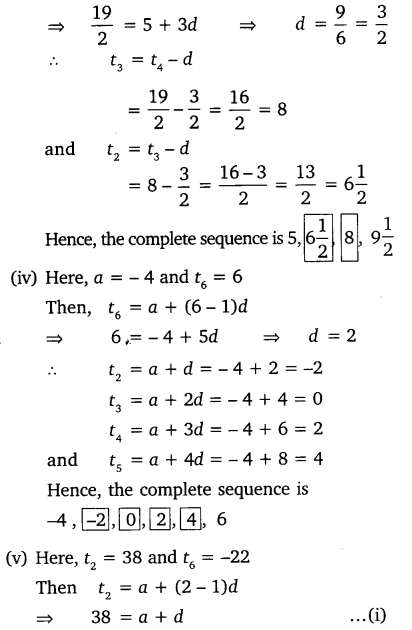
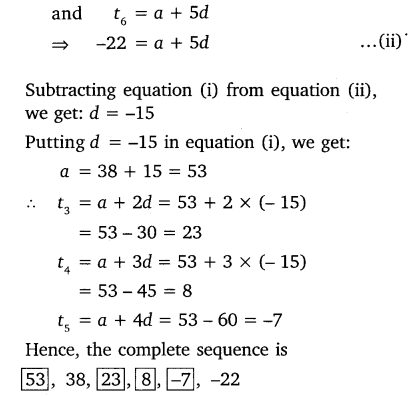
Ex 5.2 Class 10 Maths Question 4.
Which term of the AP: 3, 8, 13, 18, …, is 78?
Solution: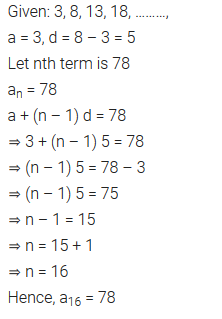
Ex 5.2 Class 10 Maths Question 5.
Find the number of terms in each of the following APs:
(i) 7, 13, 19, …, 205
(ii) 18, 15
Solution: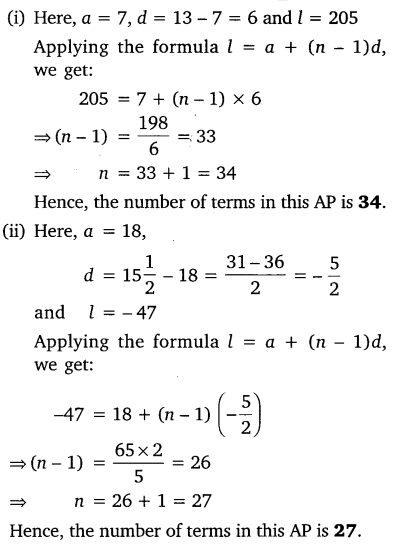
Ex 5.2 Class 10 Maths Question 6.
Check, whether -150 is a term of the AP: 11, 8, 5, 2, ….
Solution: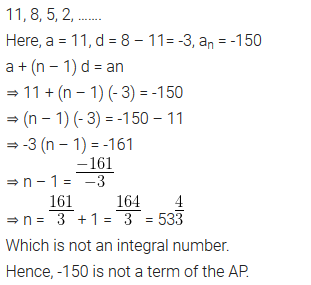
Ex 5.2 Class 10 Maths Question 7.
Find the 31st term of an AP whose 11th term is 38 and the 16th term is 73.
Solution: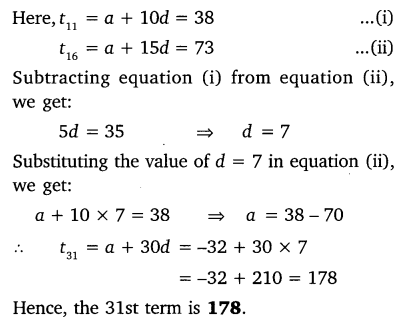
Ex 5.2 Class 10 Maths Question 8.
An AP consists of 50 terms of which 3rd term is 12 and the last term is 106. Find the 29th term.
Solution: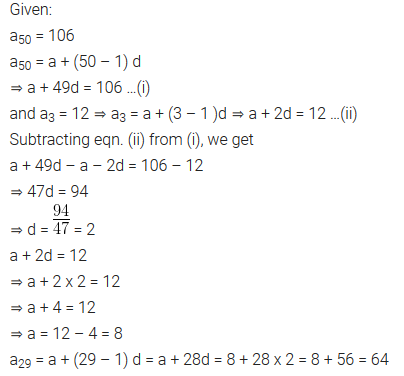
Ex 5.2 Class 10 Maths Question 9.
If the 3rd and the 9th term of an AP are 4 and -8 respectively, which term of this AP is zero?
Solution: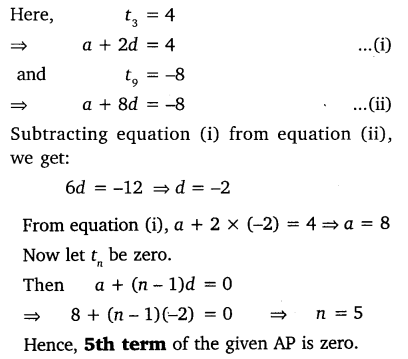
Ex 5.2 Class 10 Maths Question 10.
The 17th term of an AP exceeds its 10th term by 7. Find the common difference.
Solution: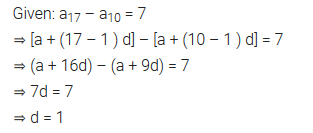
Ex 5.2 Class 10 Maths Question 11.
Which term of the AP: 3, 15, 27, 39, … will be 132 more than its 54th term?
Solution: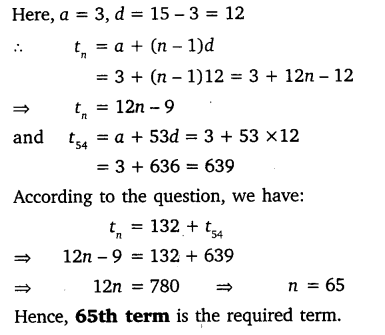
Ex 5.2 Class 10 Maths Question 12.
Two APs have the same common difference. The difference between their 100th terms is 100, what is the difference between their 1000th terms?
Solution: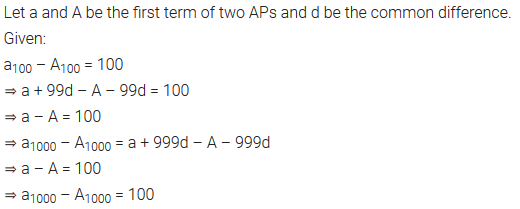
Ex 5.2 Class 10 Maths Question 13.
How many three-digit numbers are divisible by 7?
Solution: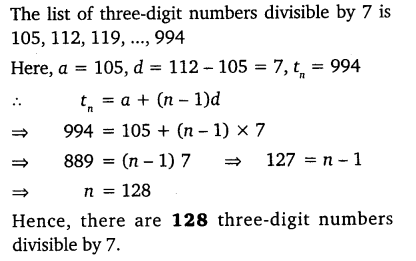
Ex 5.2 Class 10 Maths Question 14.
How many multiples of 4 lie between 10 and 250?
Solution: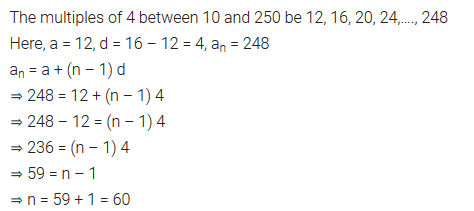
Ex 5.2 Class 10 Maths Question 15.
For what value of n, the nth term of two APs: 63, 65, 61,… and 3, 10, 17,… are equal?
Solution: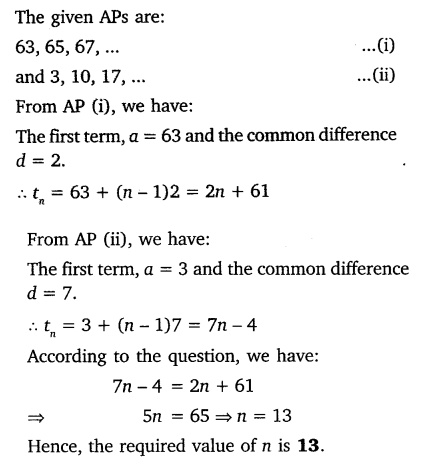
Ex 5.2 Class 10 Maths Question 16.
Determine the AP whose 3rd term is 16 and 7th term exceeds the 5th term by 12.
Solution: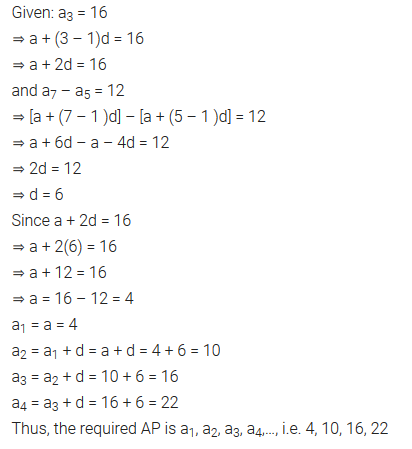
Ex 5.2 Class 10 Maths Question 17.
Find the 20th term from the last term of the AP: 3, 8, 13, …, 253.
Solution: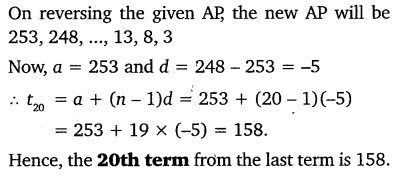
Ex 5.2 Class 10 Maths Question 18.
The sum of the 4th and 8th terms of an AP is 24 and the sum of the 6th and 10th terms is 44. Find the first three terms of the AP.
Solution: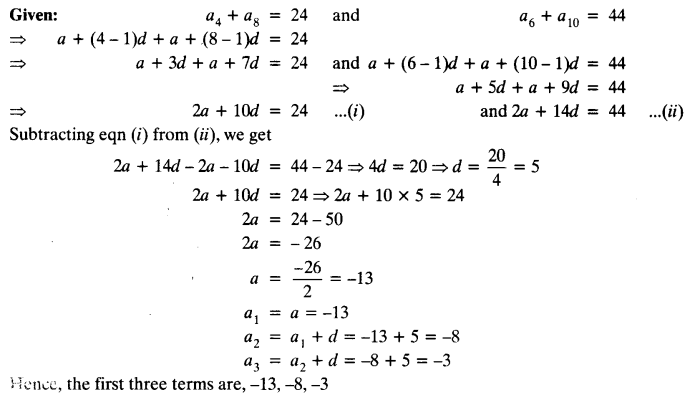
Ex 5.2 Class 10 Maths Question 19.
Subba Rao started work in 1995 at an annual salary of ₹ 5000 and received an increment of ₹ 200 each year. In which year did his income reach ₹ 7000 ?
Solution: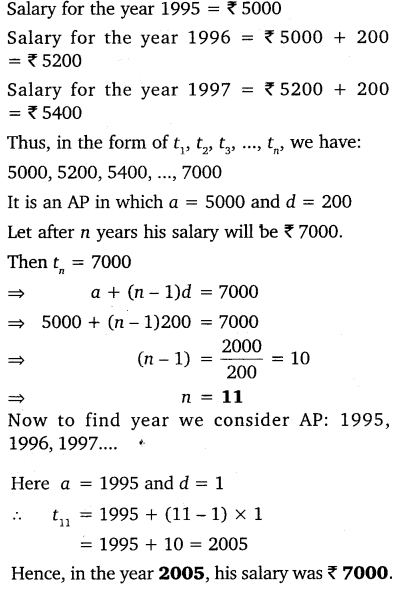
Ex 5.2 Class 10 Maths Question 20.
Ramkali saved ₹ 5 in the first week of a year and then increased her weekly saving by ₹ 1.75. If in the nth week, her weekly saving become ₹ 20.75, find n.
Solution: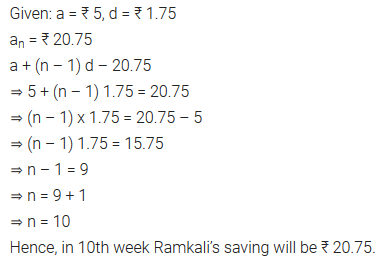
CLASS 10 MATHS CHAPTER 5 EXERCISE 5.2 AP SOLUTIONS IN HINDI
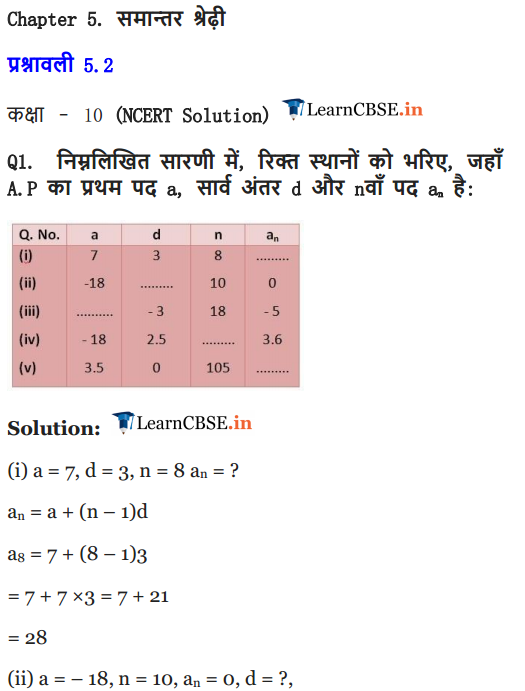
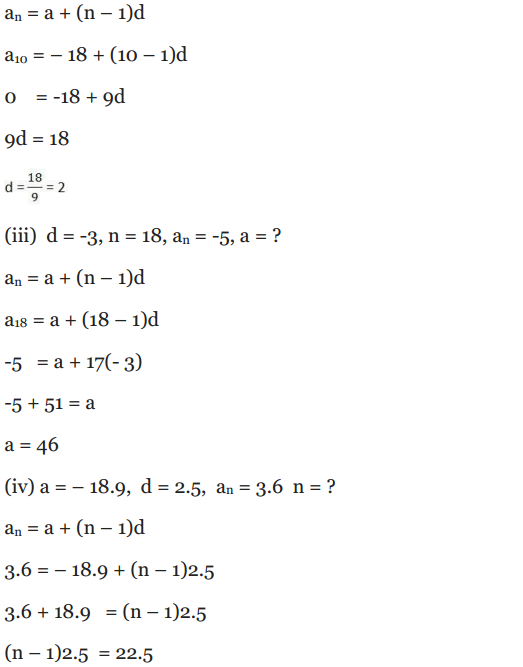
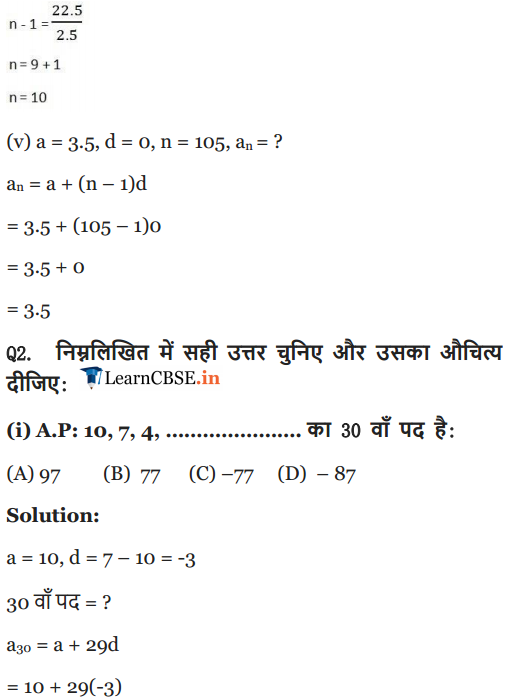
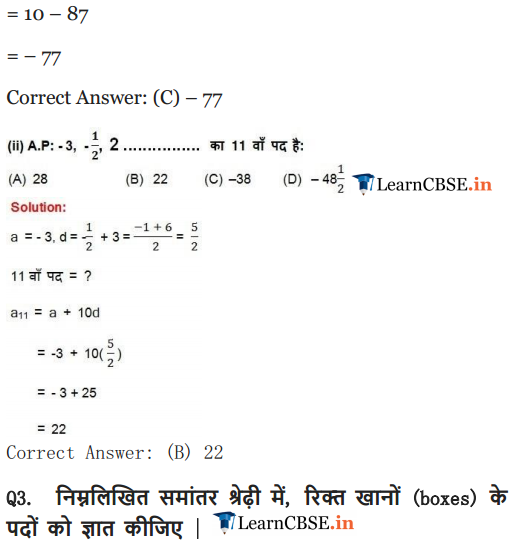
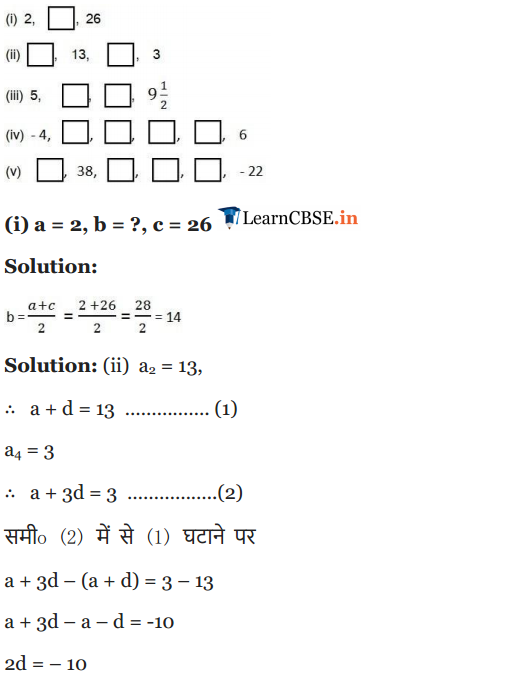
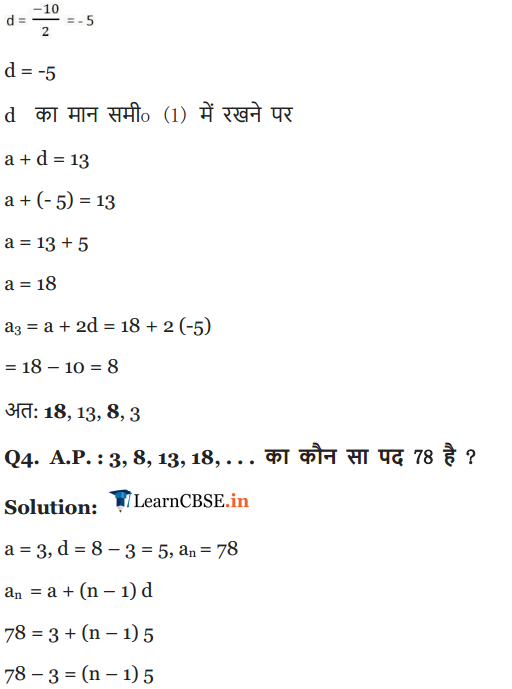
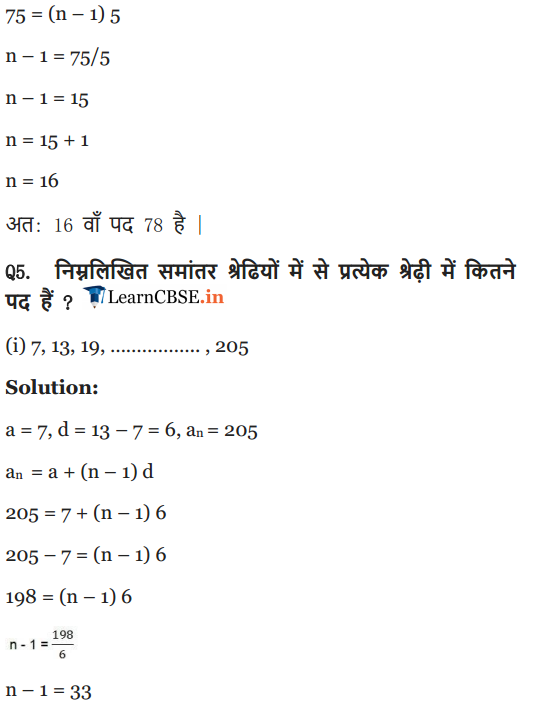
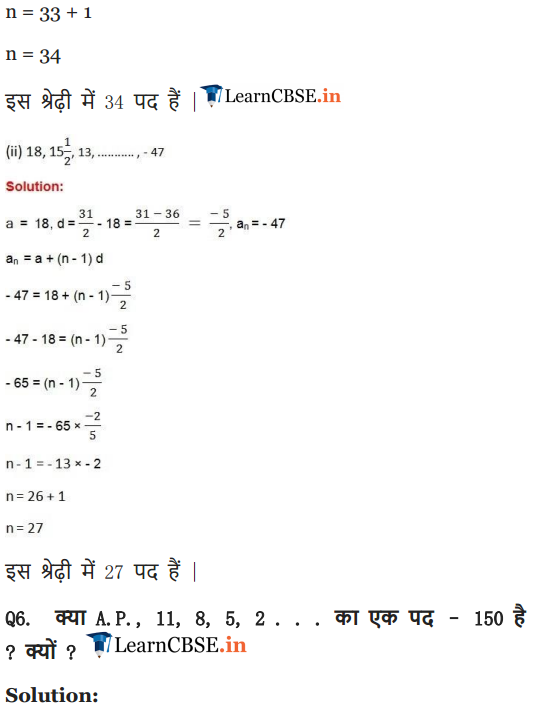
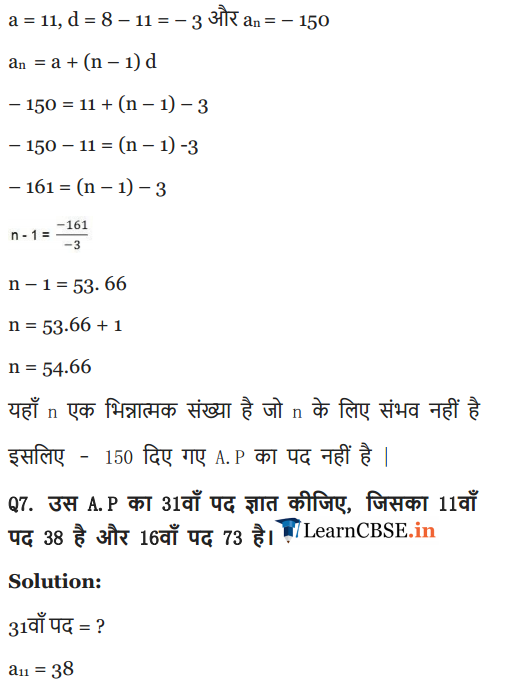
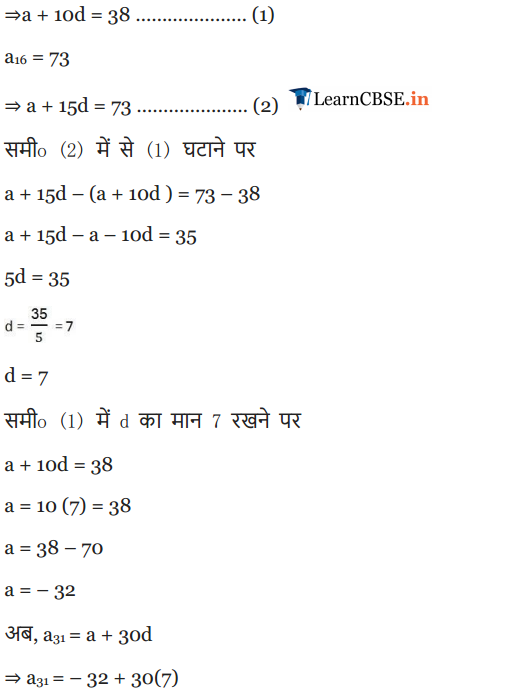
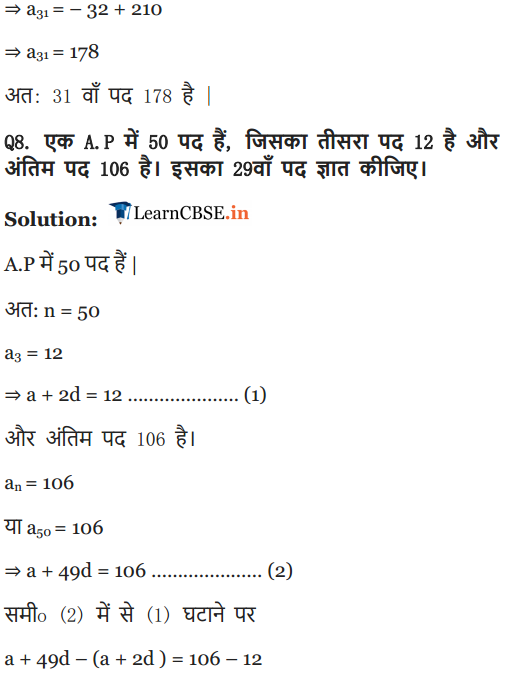
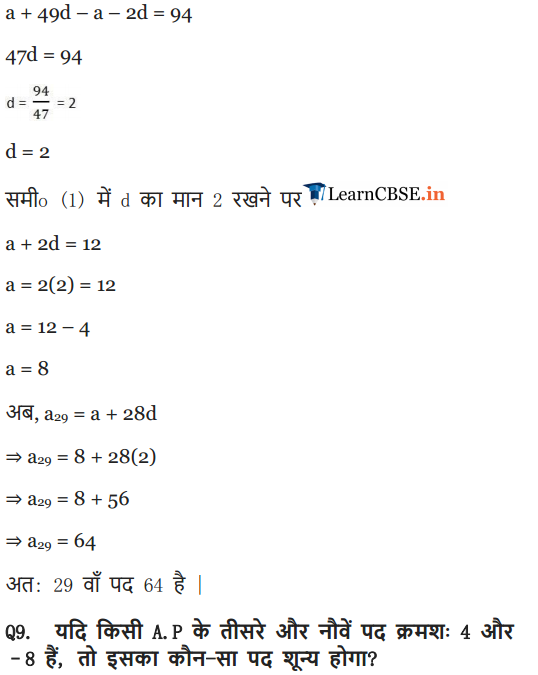
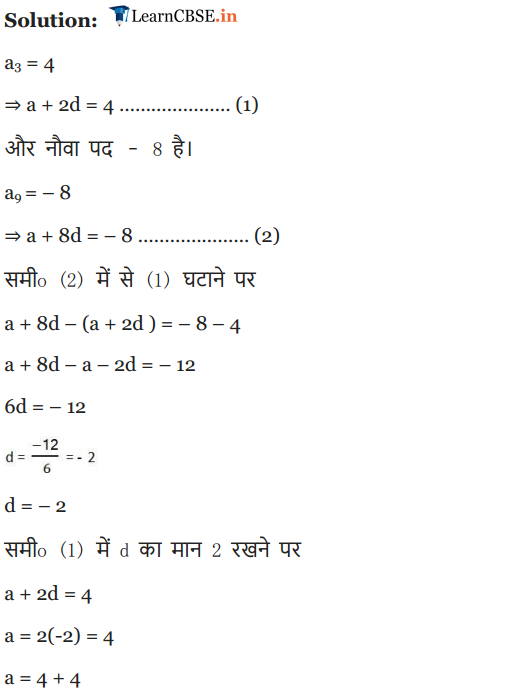
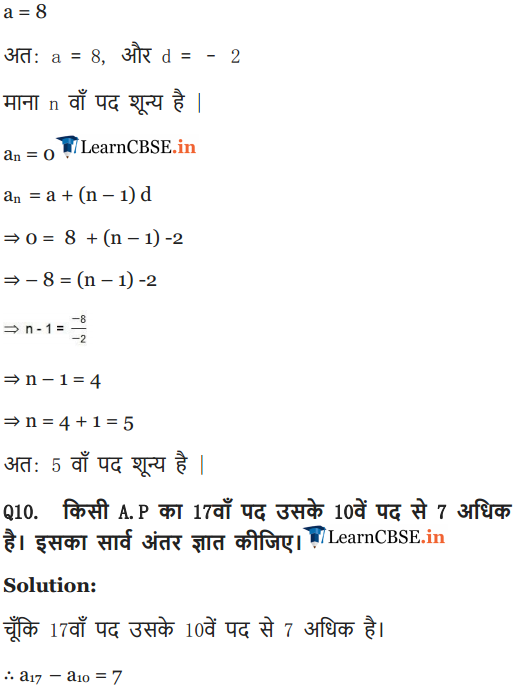
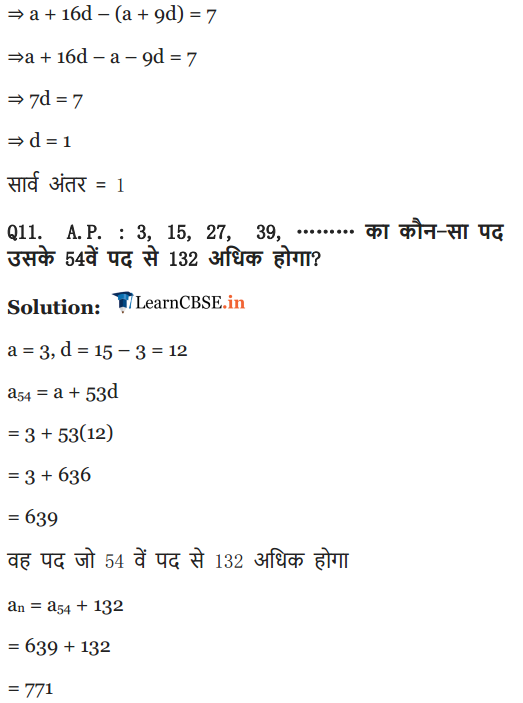
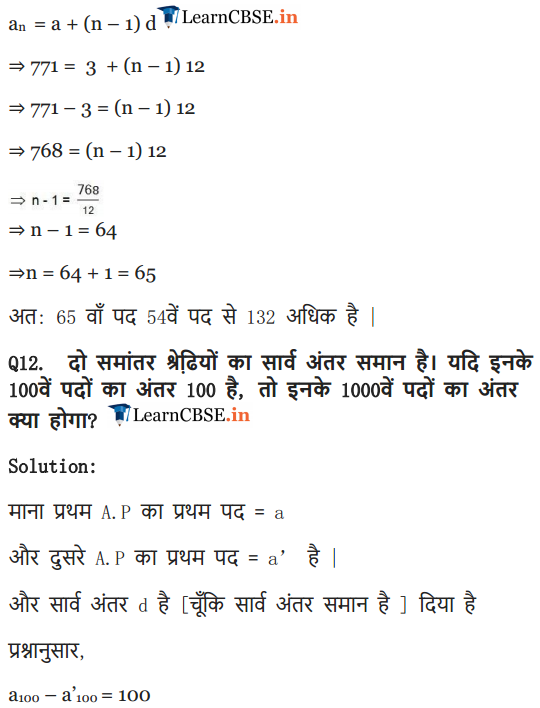
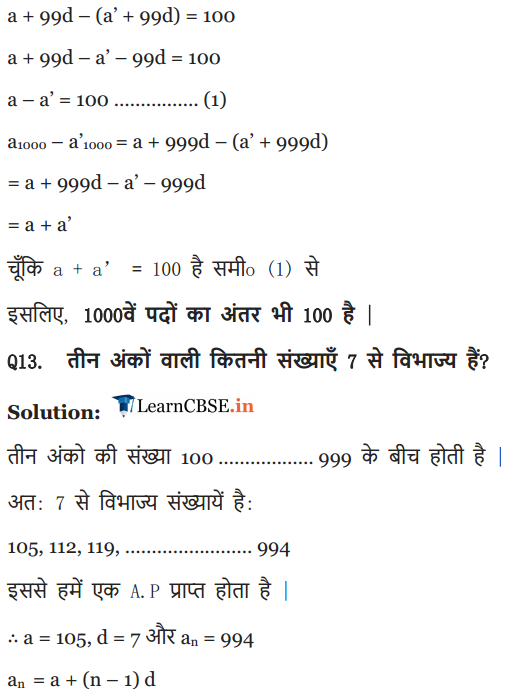
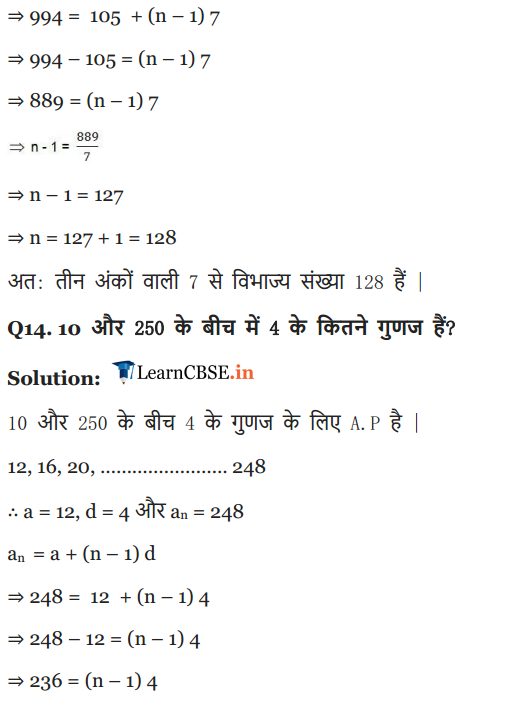
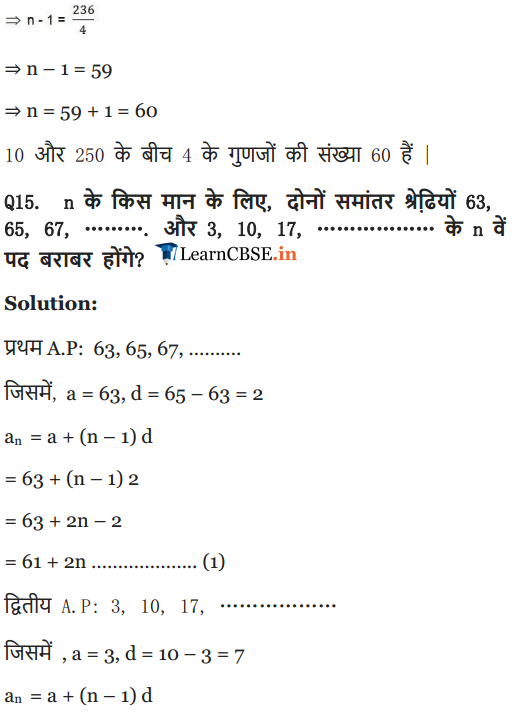
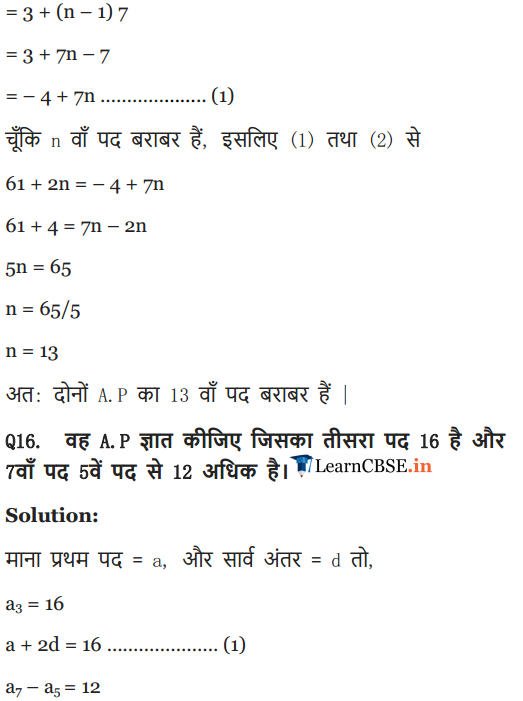
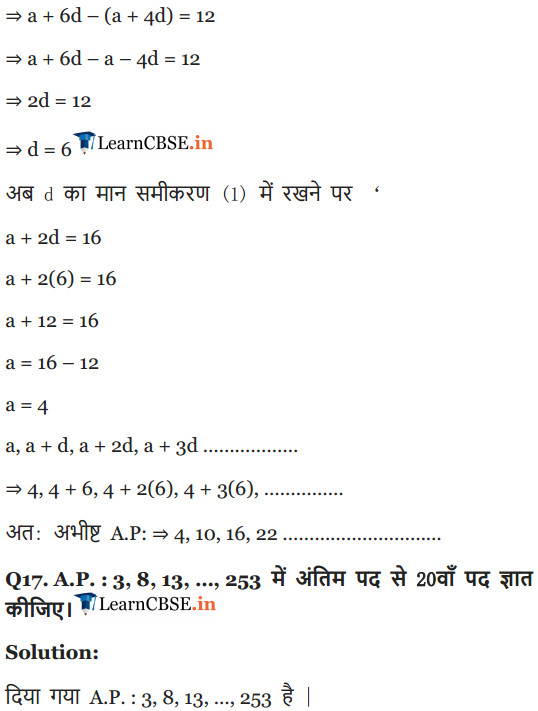
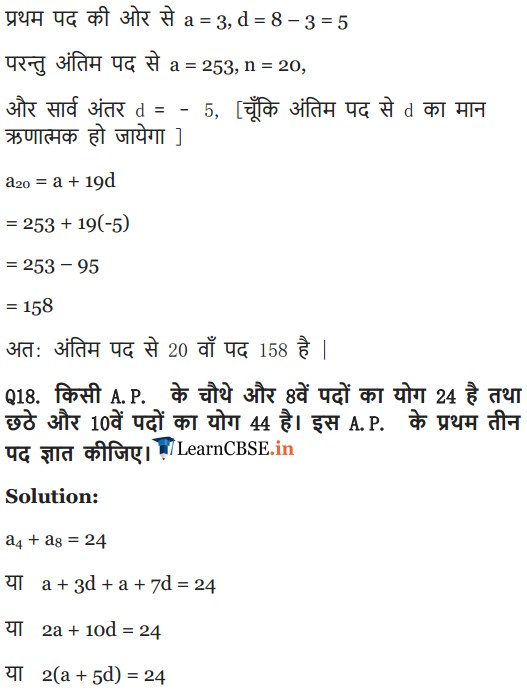
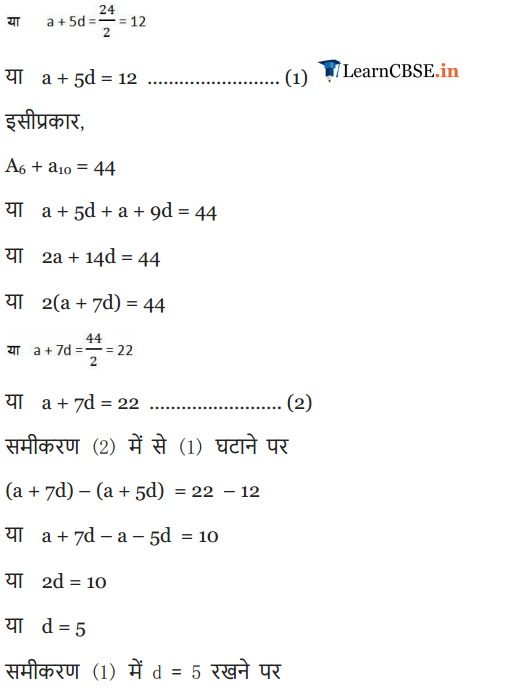
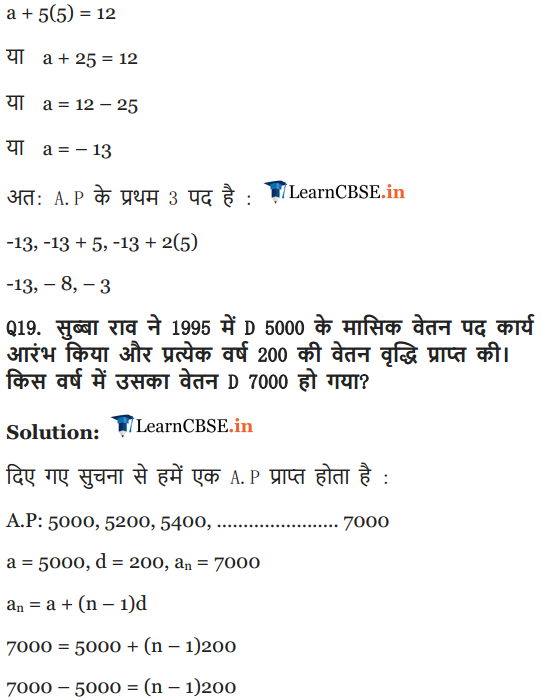
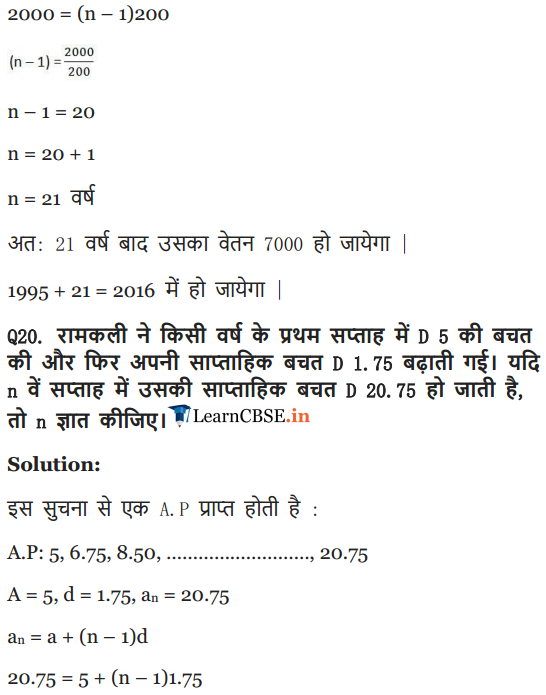
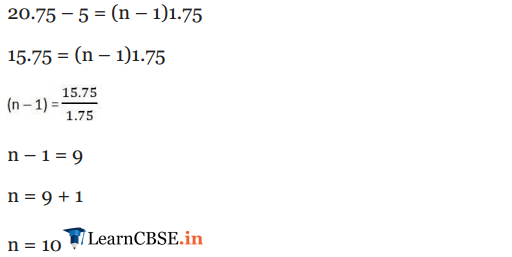
Class 10 Maths Chapter 5 Arithmetic Progressions Ex 5.3
Ex 5.3 Class 10 Maths Question 1.
Find the sum of the following APs:
(i) 2, 7, 12,…… to 10 terms.
(ii) -37, -33, -29, …… to 12 terms.
(iii) 0.6, 1.7, 2.8, ……, to 100 terms.
(iv)
Solution: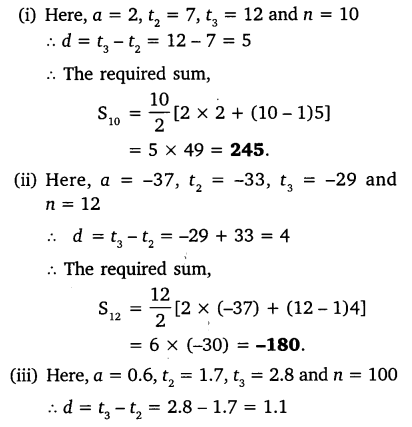
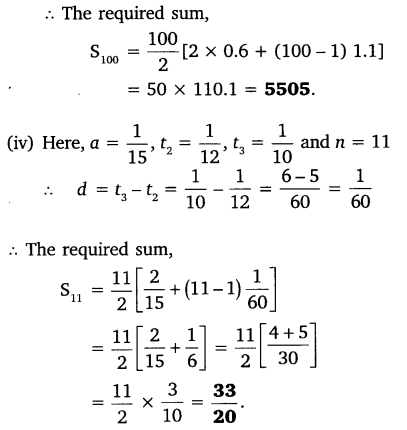
Ex 5.3 Class 10 Maths Question 2.
Find the sums given below:
(i) 7 + 10
(ii) 34 + 32 + 30 + … + 10
(iii) -5 + (-8) + (-11) + ….. + (-230)
Solution: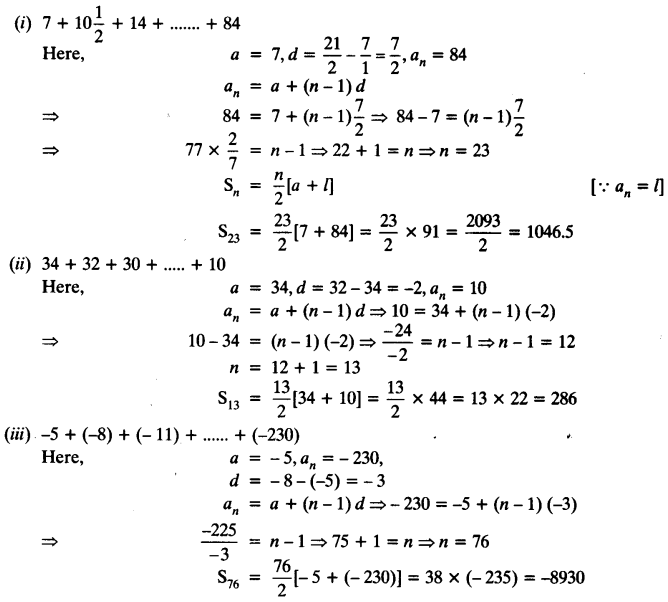
Download NCERT Solutions For Class 10 Maths Chapter 5 Arithmetic Progressions PDF
Ex 5.3 Class 10 Maths Question 3.
In an AP:
(i) given a = 5, d = 3, an = 50, find n and Sn.
(ii) given a = 7, a13 = 35, find d and S13.
(iii) given a12 = 37, d = 3, find a and S12.
(iv) given a3 = -15, S10 = 125, find d and a10.
(v) given d = 5, S9 = 75, find a and a9.
(vi) given a = 2, d = 8, Sn = 90, find n and an.
(vii) given a = 8, an = 62, Sn = 210, find n and d.
(viii) given an = 4, d = 2, Sn = -14, find n and a.
(ix) given a = 3, n = 8, S = 192, find d.
(x) given l = 28, S = 144, and there are total 9 terms. Find a.
Solution: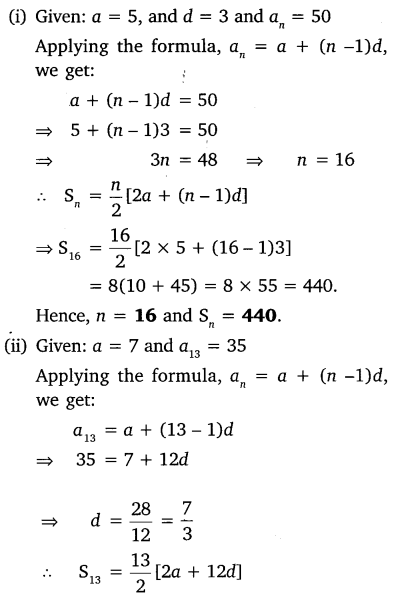
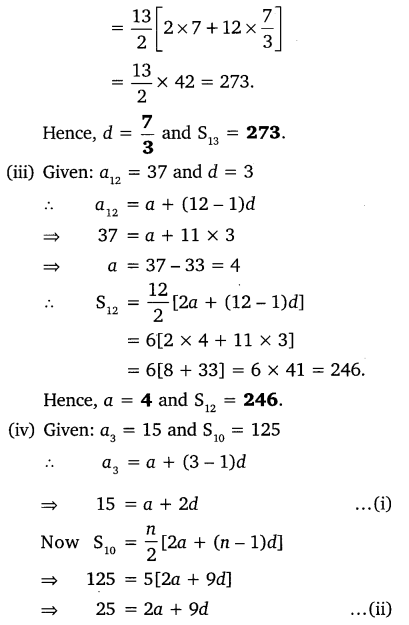
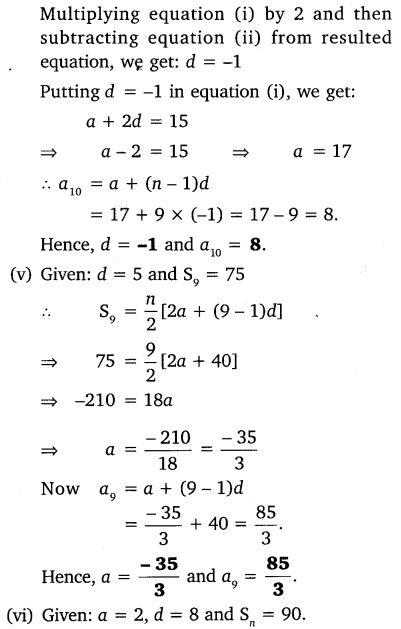
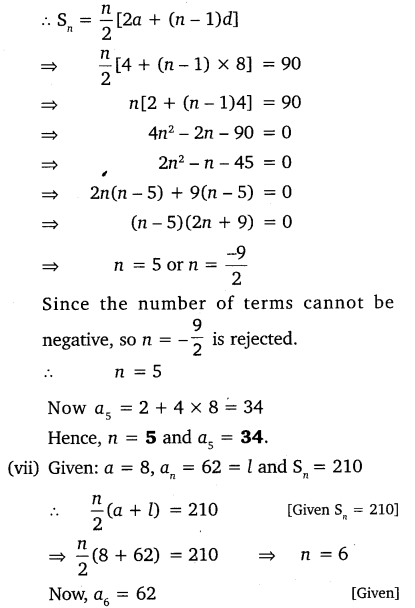
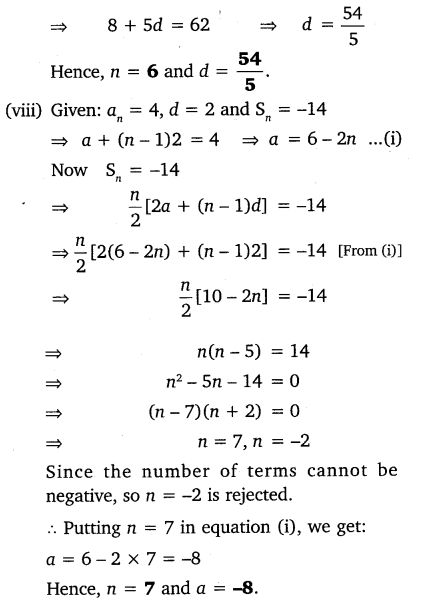
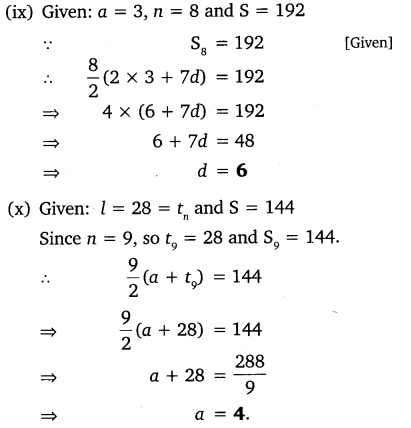
Ex 5.3 Class 10 Maths Question 4.
How many terms of AP: 9, 17, 25, … must be taken to give a sum of 636?
Solution: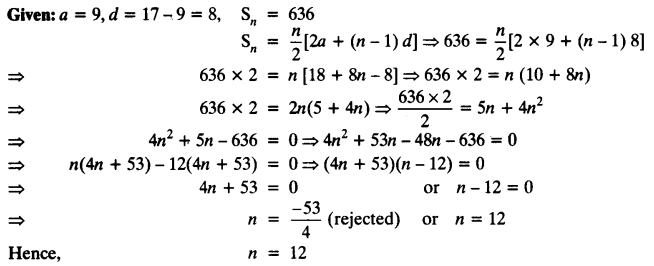
Ex 5.3 Class 10 Maths Question 5.
The first term of an AP is 5, the last term is 45 and the sum is 400. Find the number of terms and the common difference.
Solution: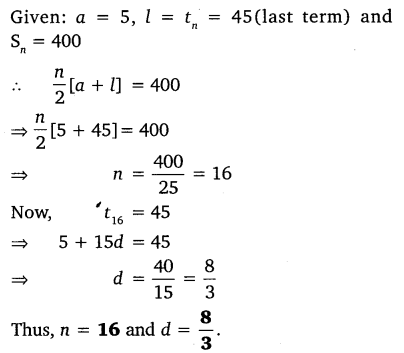
Ex 5.3 Class 10 Maths Question 6.
The first and the last terms of an AP are 17 and 350 respectively. If the common difference is 9, how many terms are there and what is their sum?
Solution:
Ex 5.3 Class 10 Maths Question 7.
Find the sum of first 22 terms of an AP in which d = 7 and 22nd term is 149.
Solution: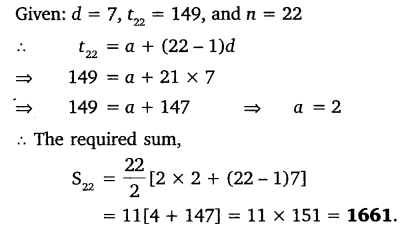
Ex 5.3 Class 10 Maths Question 8.
Find the sum of first 51 terms of an AP whose second and third terms are 14 and 18 respectively.
Solution: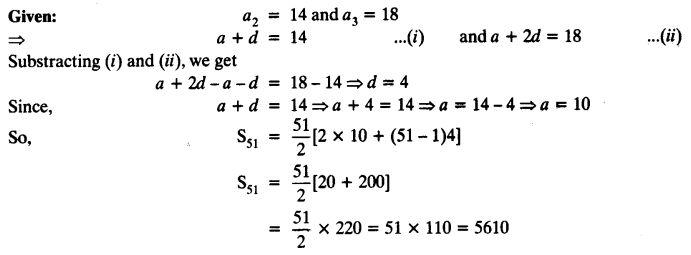
Ex 5.3 Class 10 Maths Question 9.
If the sum of first 7 terms of an AP is 49 and that of 17 terms is 289, find the sum of first n terms.
Solution: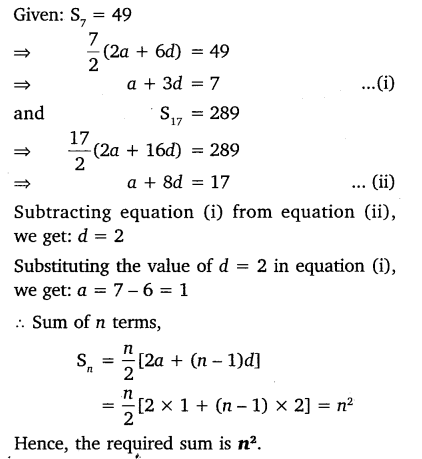
Ex 5.3 Class 10 Maths Question 10.
Show that a1, a2, ……. an,…… form an AP where an is defined as below:
(i) an = 3 + 4n
(ii) an = 9 – 5n
Also find the sum of the first 15 terms in each case.
Solution: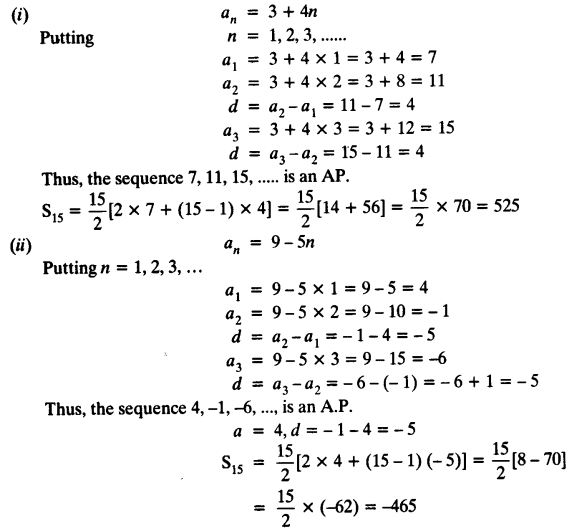
Ex 5.3 Class 10 Maths Question 11.
If the sum of the first n terms of an AP is 4n – n2, what is the first term (that is S1)? What is the sum of first two terms? What is the second term? Similarly, find the 3rd, the 10th and the nth terms.
Solution: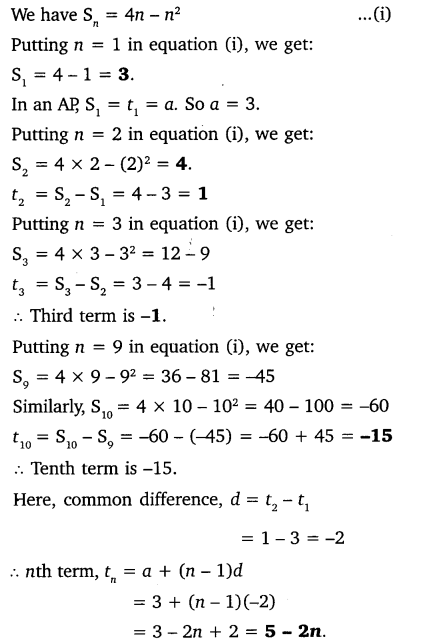
Ex 5.3 Class 10 Maths Question 12.
Find the sum of the first 40 positive integers divisible by 6.
Solution:
Ex 5.3 Class 10 Maths Question 13.
Find the sum of the first 15 multiples of 8.
Solution: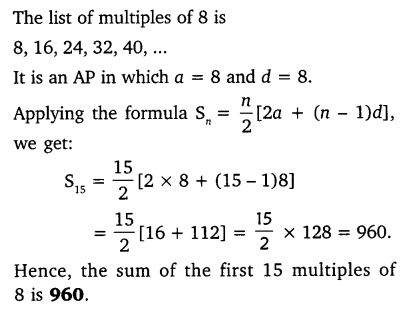
Ex 5.3 Class 10 Maths Question 14.
Find the sum of the odd numbers between 0 and 50.
Solution: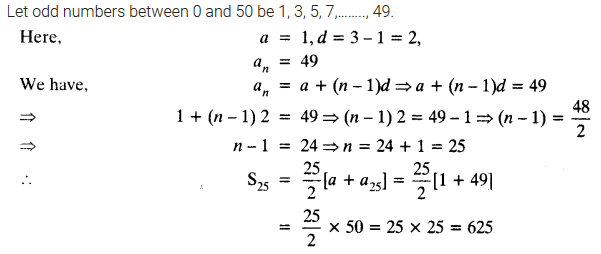
Ex 5.3 Class 10 Maths Question 15.
A contract on construction job specifies a penalty for delay of completion beyond a certain date as follows:
₹ 200 for the first day, ₹ 250 for the second day, ₹ 300 for the third day, etc. the penalty for each succeeding day being ₹ 50 more than for the preceding day. How much money the contractor has to pay as penalty, if he has delayed the work by 30 days?
Solution: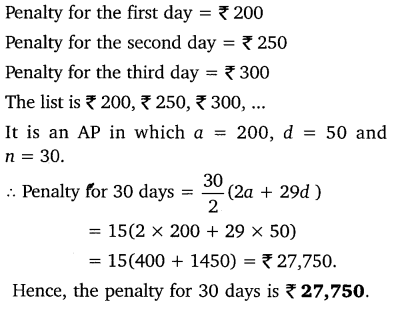
Ex 5.3 Class 10 Maths Question 16.
A sum of ₹ 700 is to be used to give seven cash prizes to students of a school for their overall academic performance. If each prize is ₹ 20 less than its preceding prize, find the value of each of the prizes.
Solution: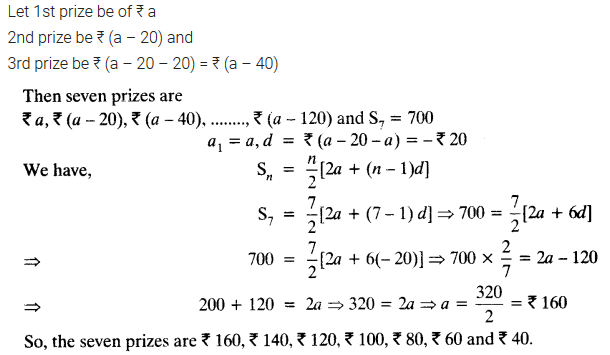
Ex 5.3 Class 10 Maths Question 17.
In a school, students thought of planting trees in and around the school to reduce air pollution. It was decided that the number of trees, that each section of each class will plant, will be the same as the class, in which they are studying, eg. a section of Class I will plant 1 tree, a section of Class II will plant 2 trees and so on till Class XII. There are three sections of each class. How many trees will be planted by the students?
Solution: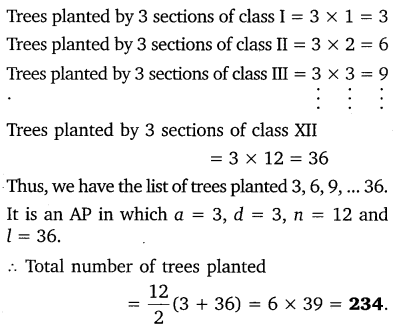
Ex 5.3 Class 10 Maths Question 18.
A spiral is made up of successive semicircles, with centres alternately at A and B, starting with centre at A, of radii 0.5 cm, 1.0 cm, 1.5 cm, 2.0 cm,… as shown in figure. What is the total length of such a spiral made up of thirteen consecutive semicircles?
(Take π =
[Hint: Length of successive semicircles is l1, l2, l3, l4, … with centres at A, B, respectively.]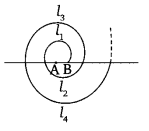
Solution:
Ex 5.3 Class 10 Maths Question 19.
200 logs are stacked in the following manner 20 logs in the bottom row, 19 in the next row, 18 in the row next to it and so on (see Figure). In how many rows are the 200 logs placed and how many logs are in the top row?
Solution: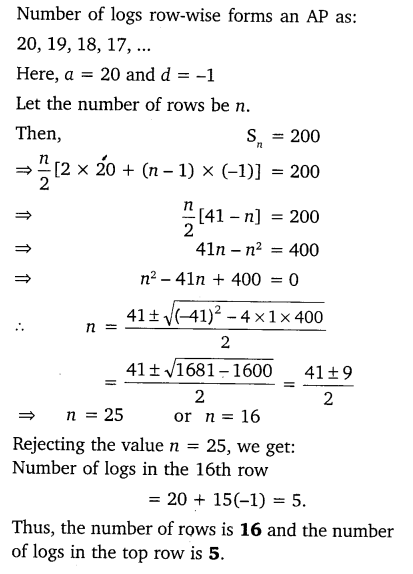
Ex 5.3 Class 10 Maths Question 20.
In a potato race, a bucket is placed at the starting point, which is 5 m from the first potato, and the other potatoes are placed 3 m apart in a straight line. There are ten potatoes in the line
A competitor starts from the bucket, picks up the nearest potato, runs back with it, drops it in the bucket, runs back to pick up the next potato, runs to the bucket to drop it in, and she continues in the same way until all the potatoes are in the bucket. What is the total distance the competitor has to run?
Solution: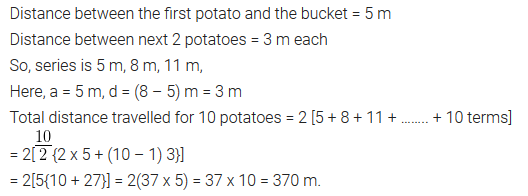
CLASS 10 MATHS CHAPTER 5 EXERCISE 5.3 AP SOLUTIONS IN HINDI Medium
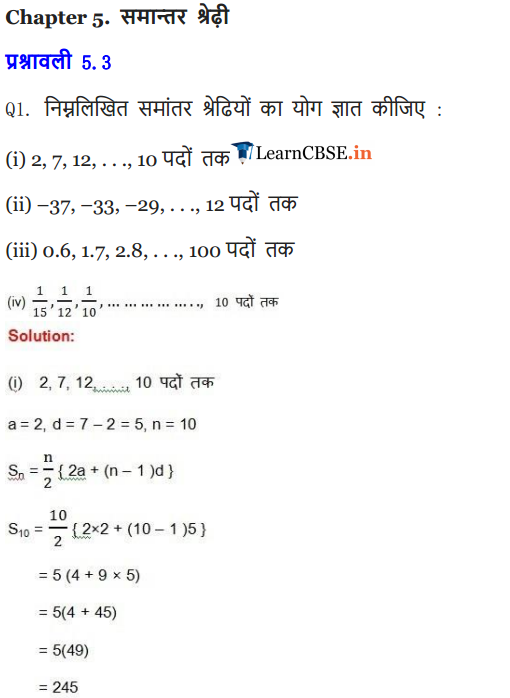
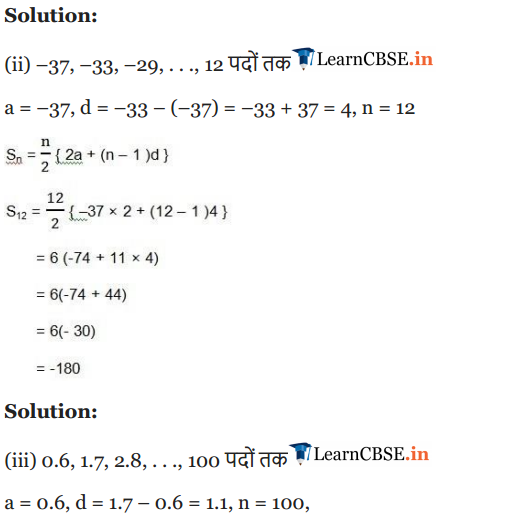
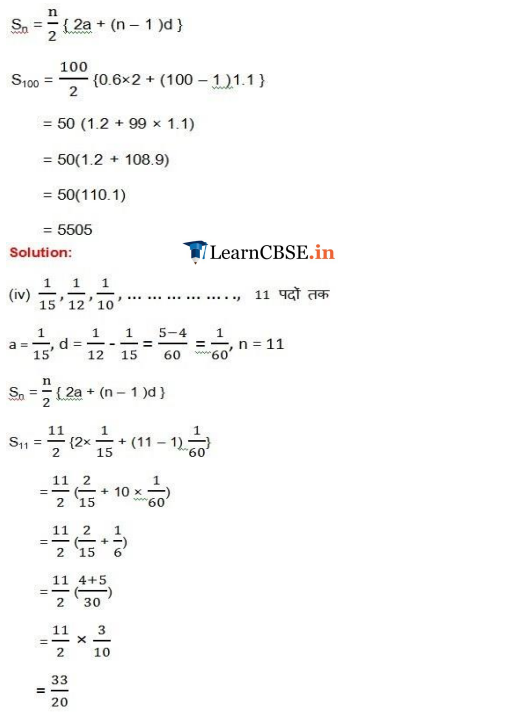
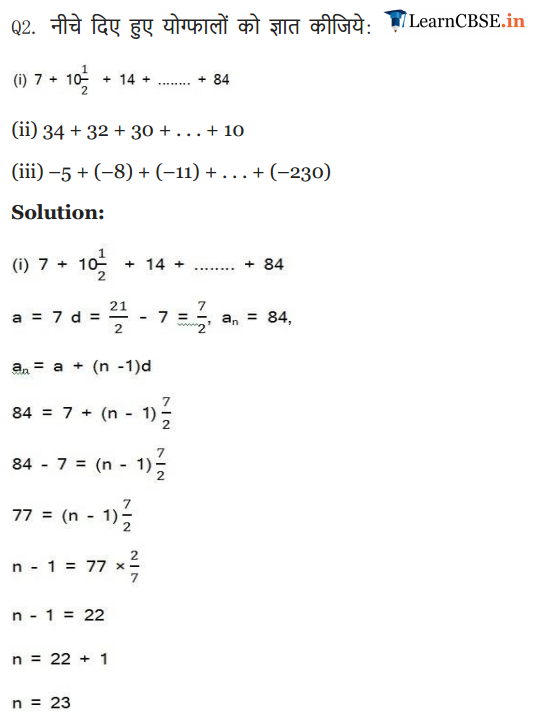
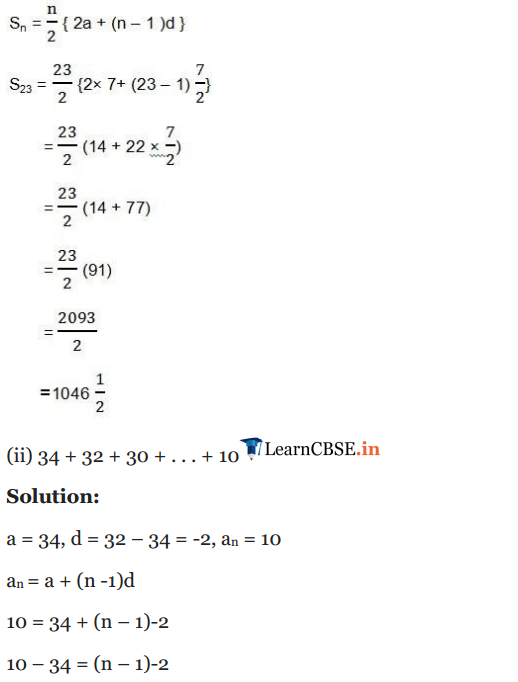
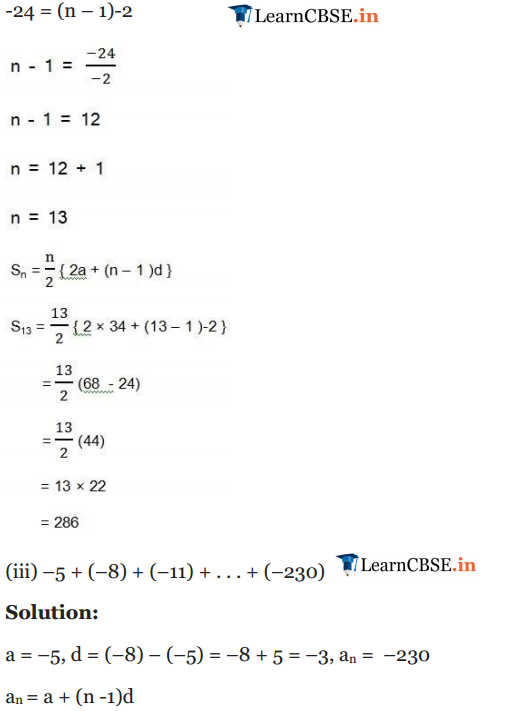
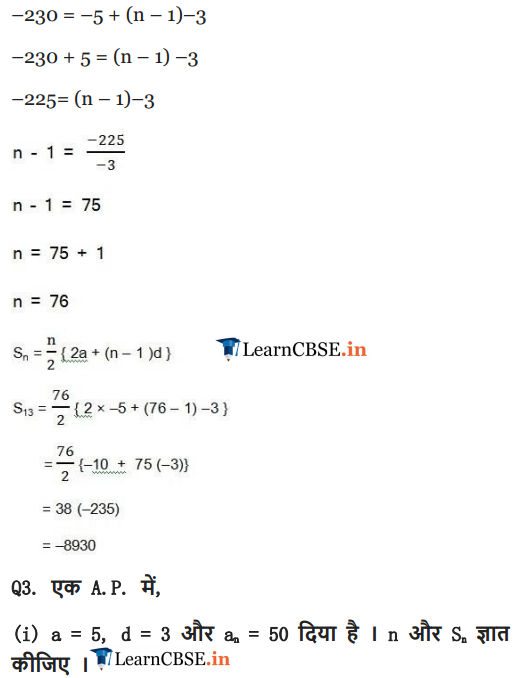
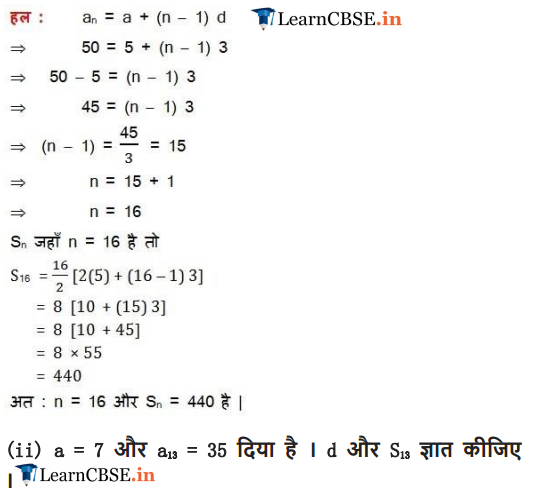
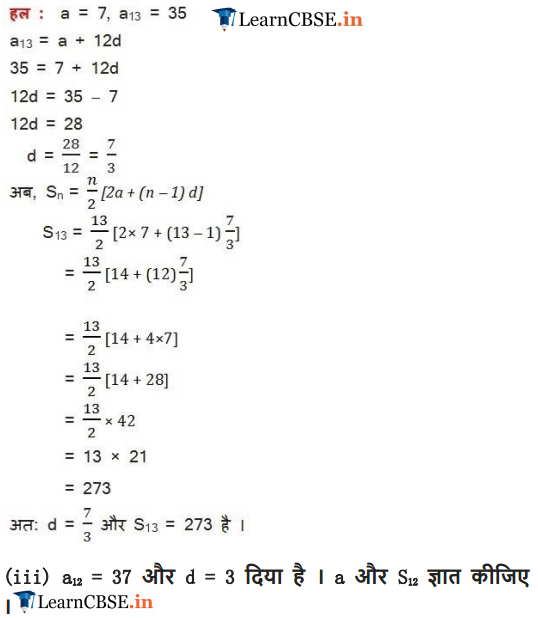
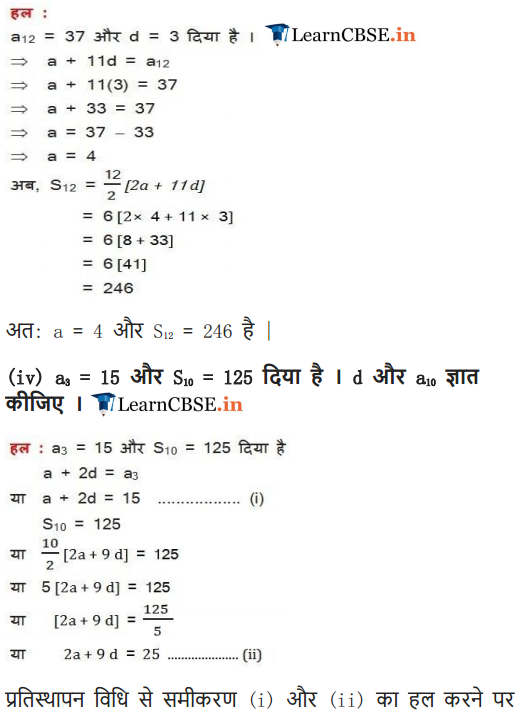
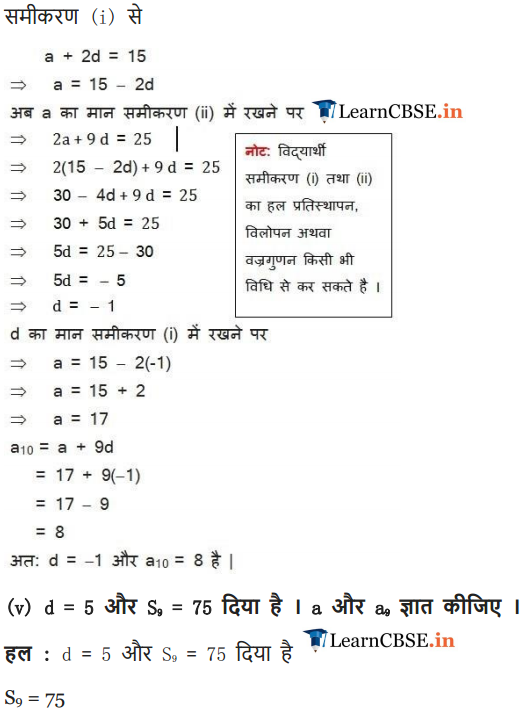
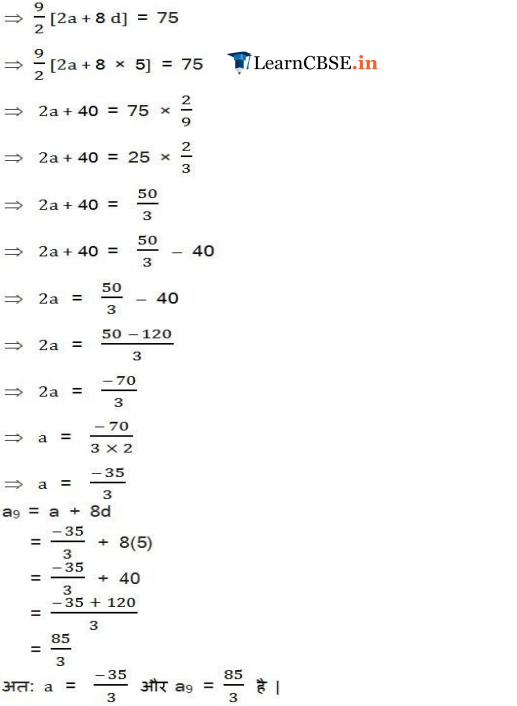
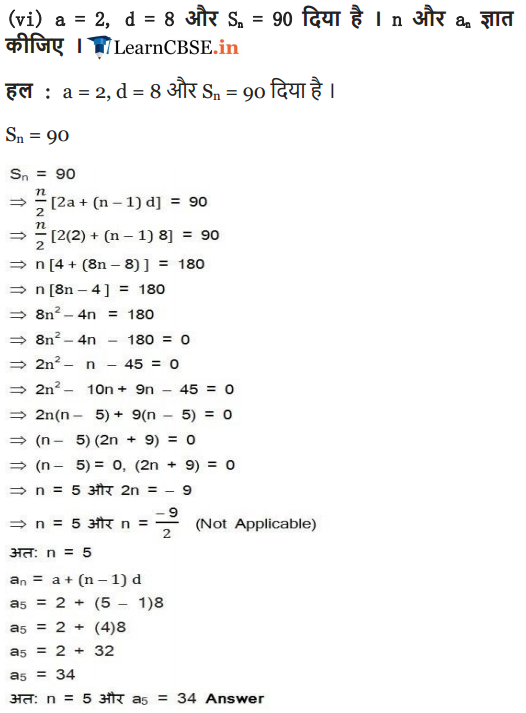
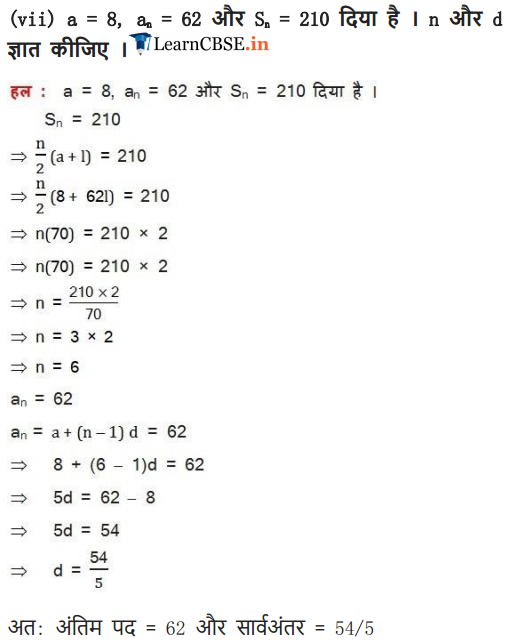
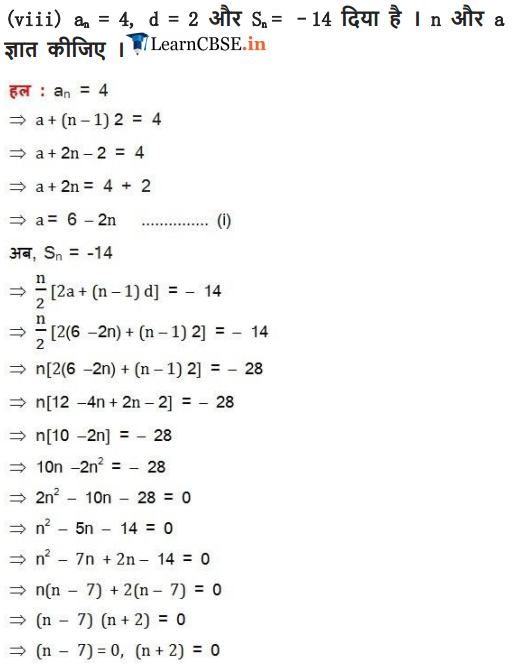
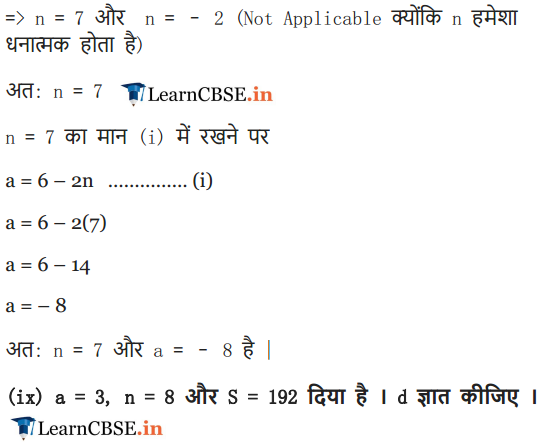
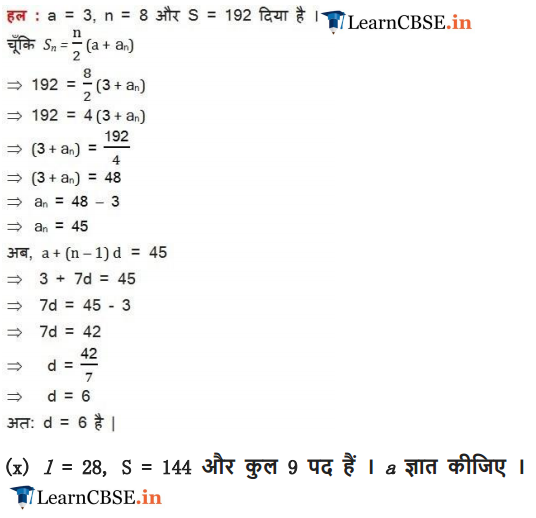
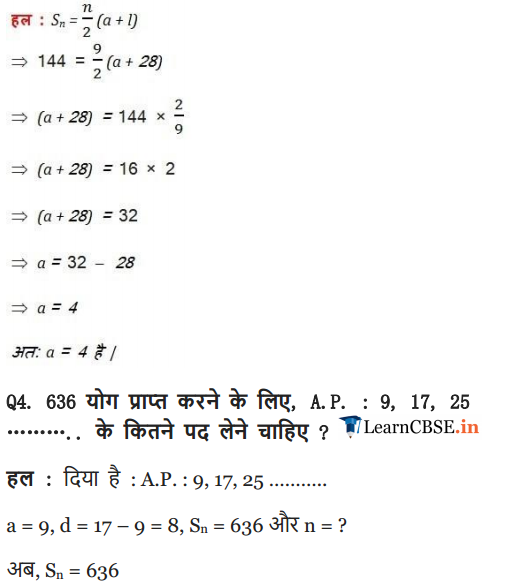
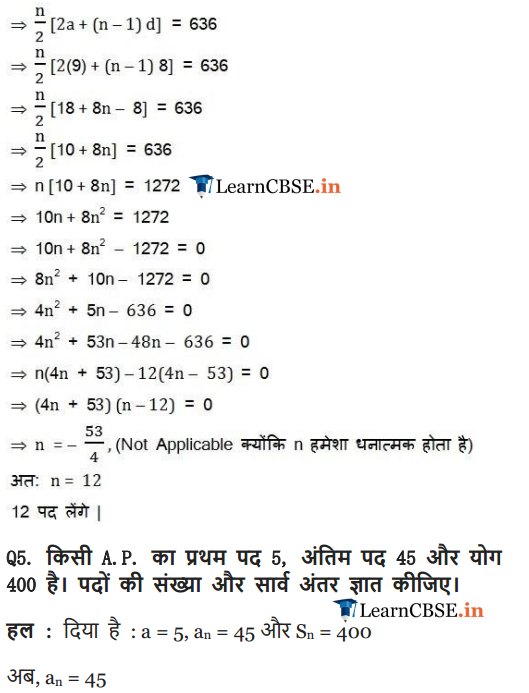
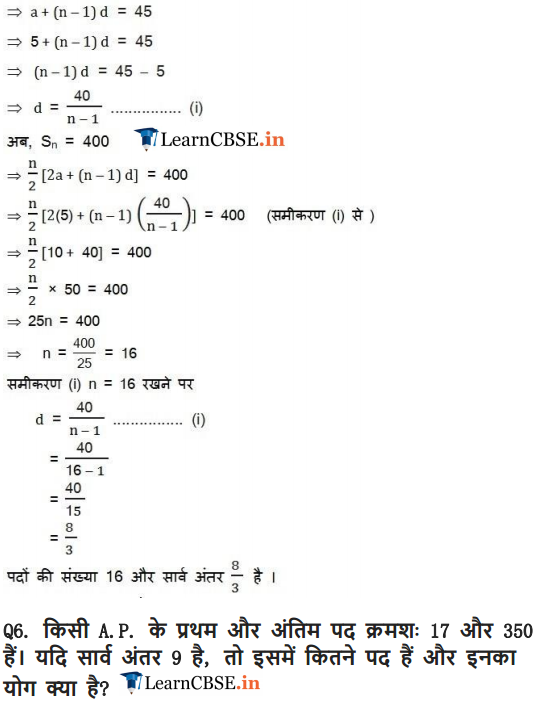
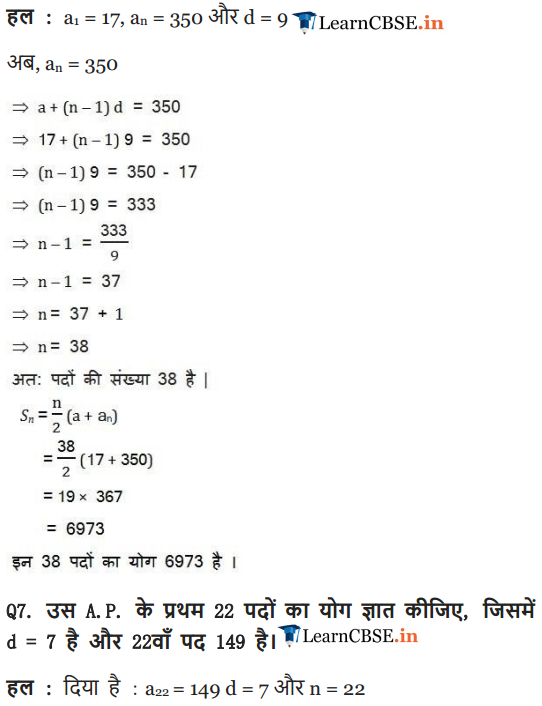
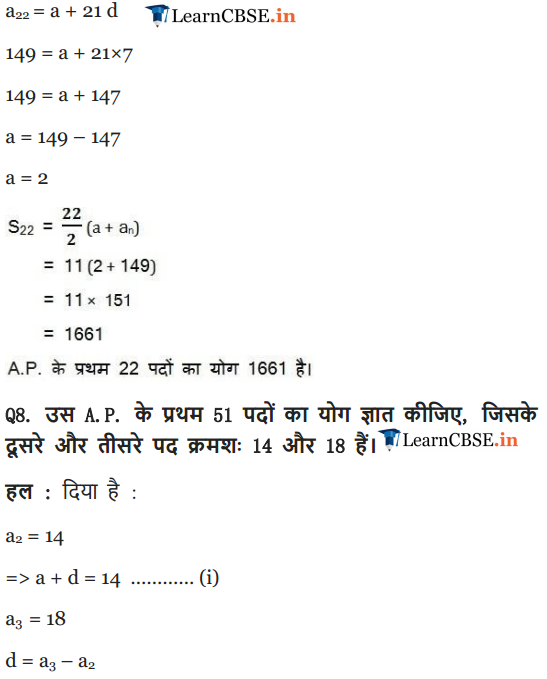
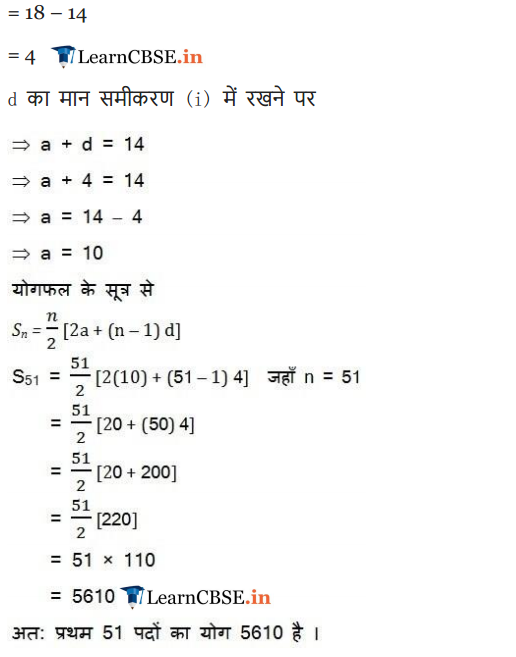

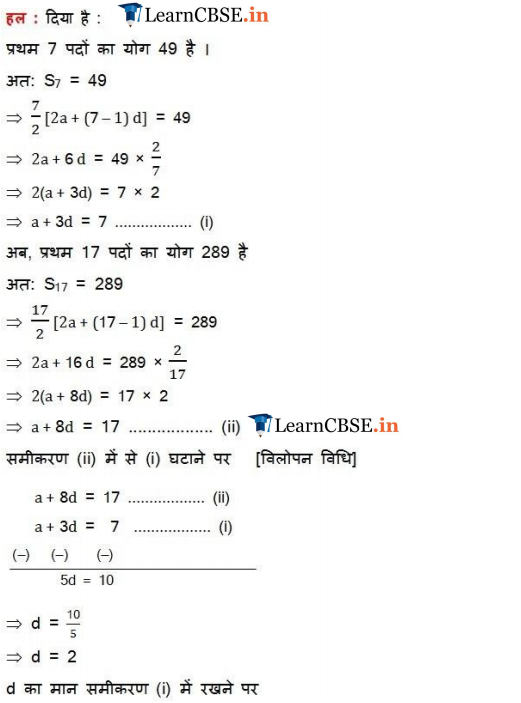
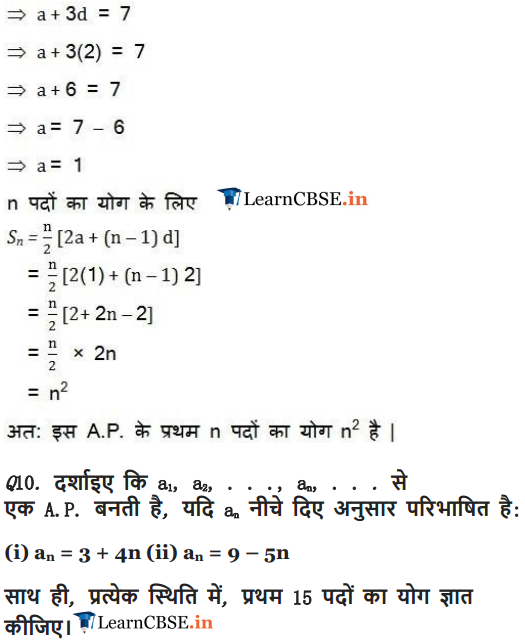
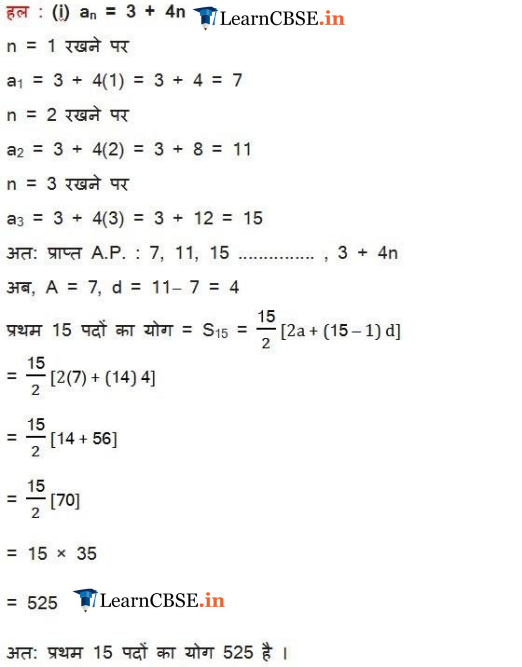
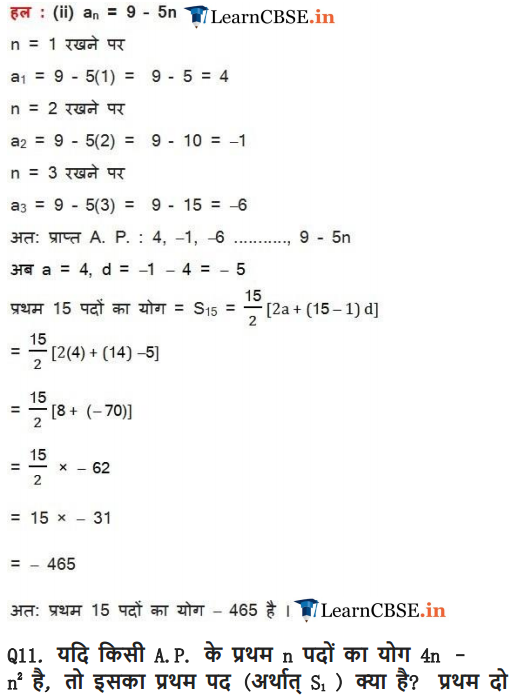
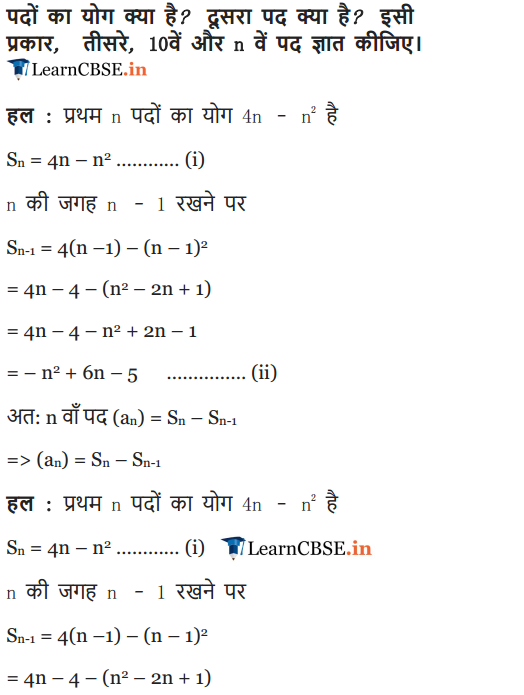
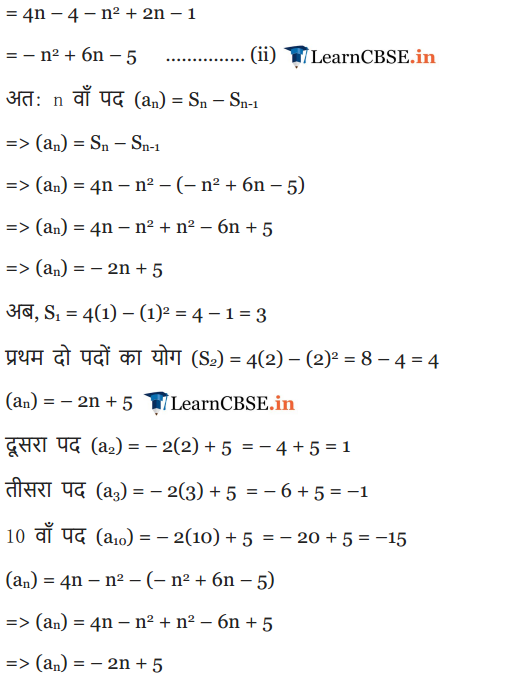
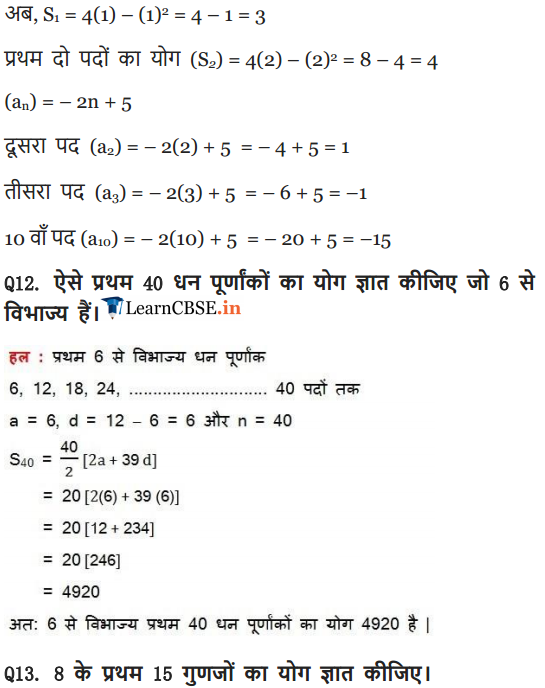
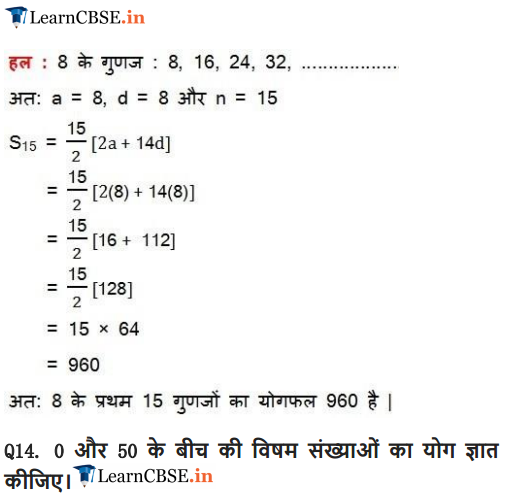
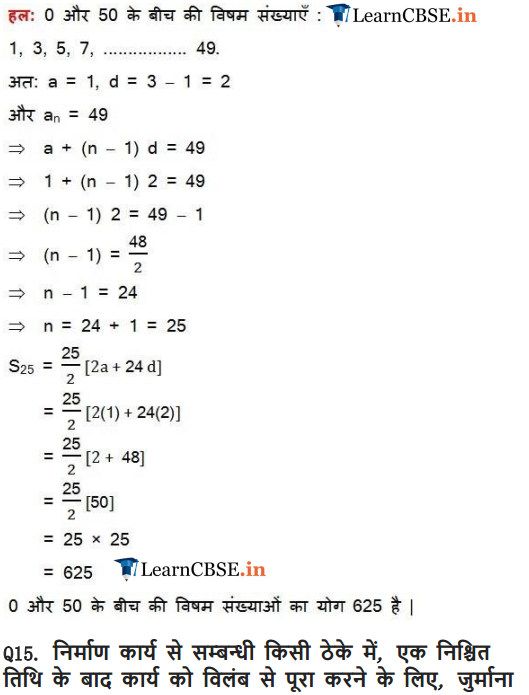
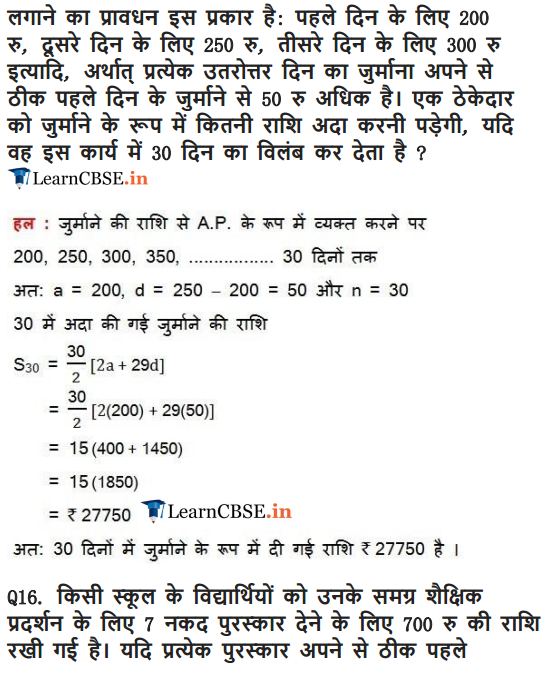
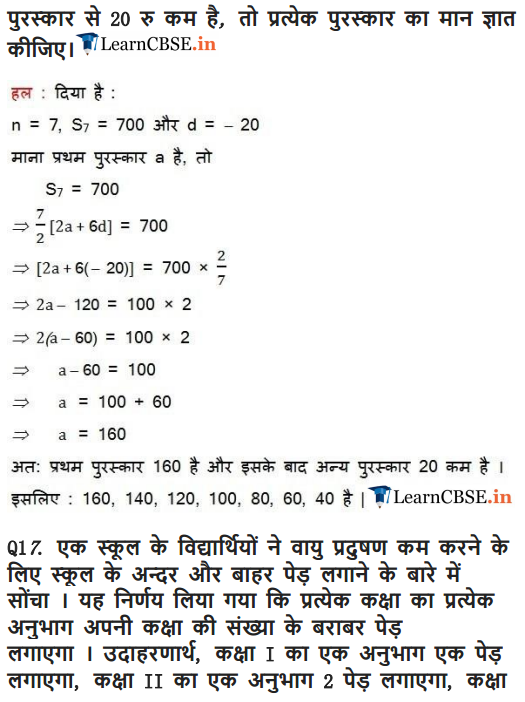
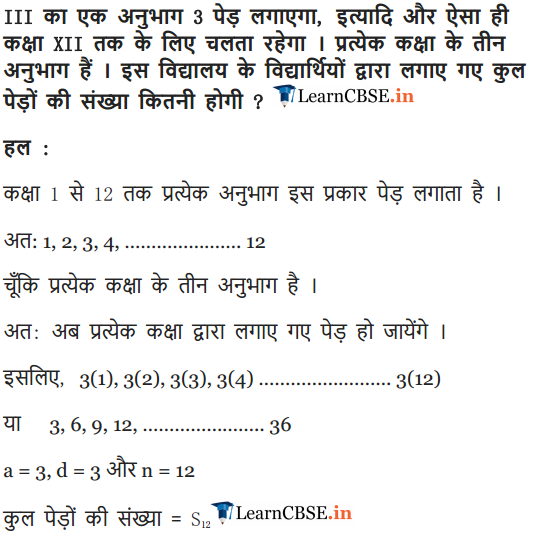
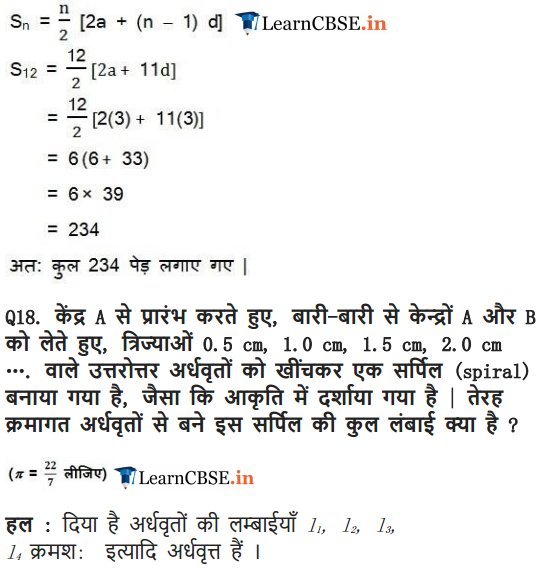
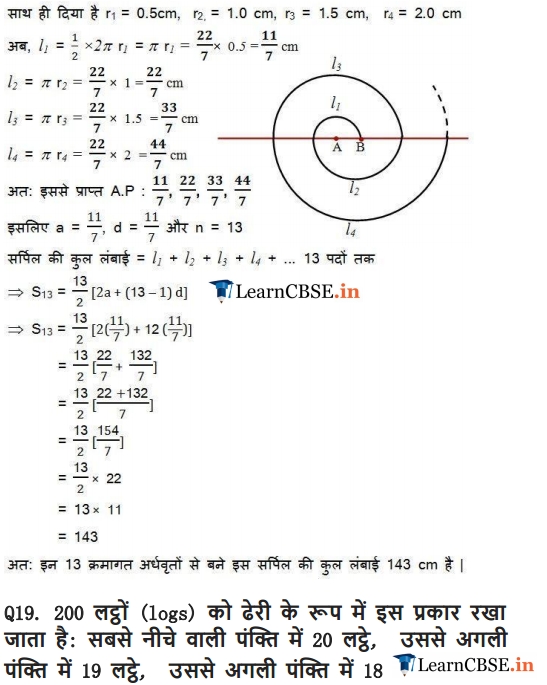
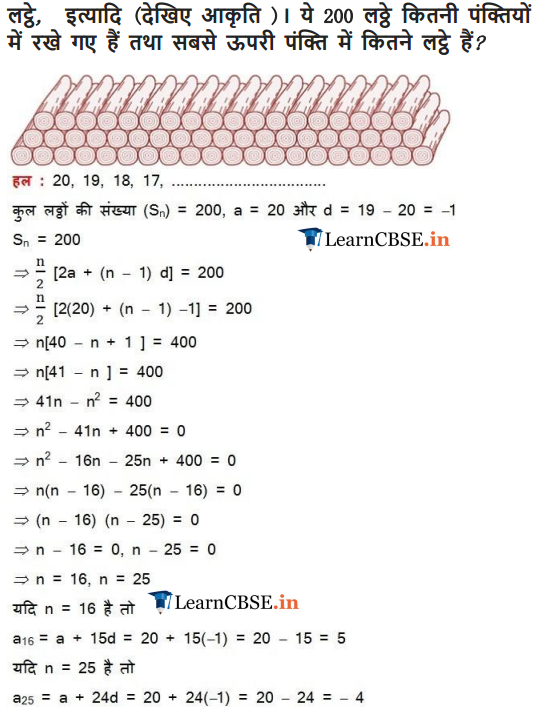
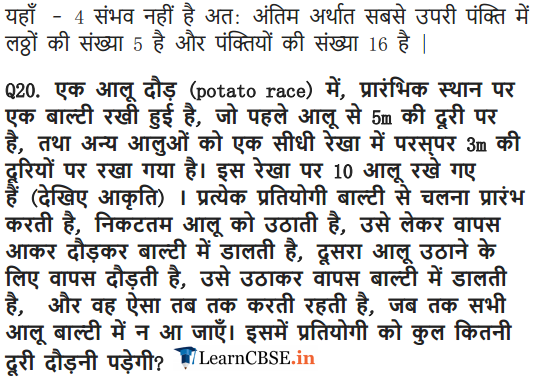
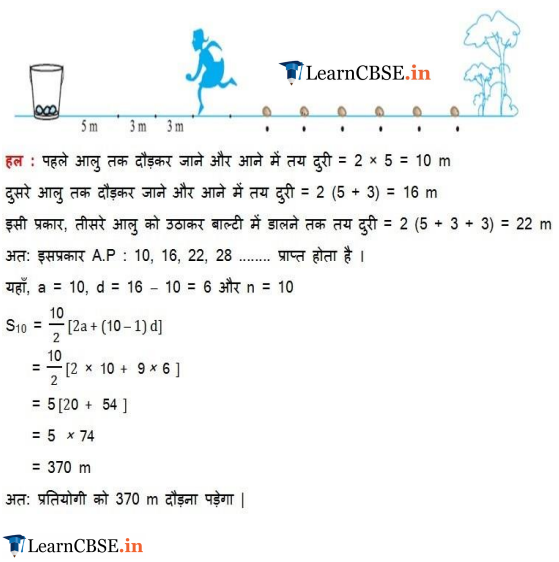
Class 10 Maths Chapter 5 Arithmetic Progressions Ex 5.4
Ex 5.4 Class 10 Maths Question 1.
Which term of the AP: 121, 117. 113, ….., is its first negative term?
Solution: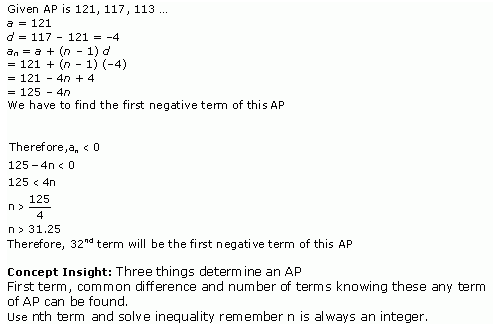
Ex 5.4 Class 10 Maths Question 2.
The sum of the third term and the seventh term of an AP is 6 and their product is 8. Find the sum of first sixteen terms of the AP?
Solution: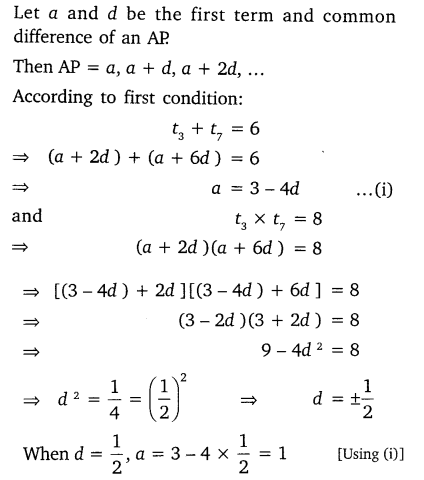
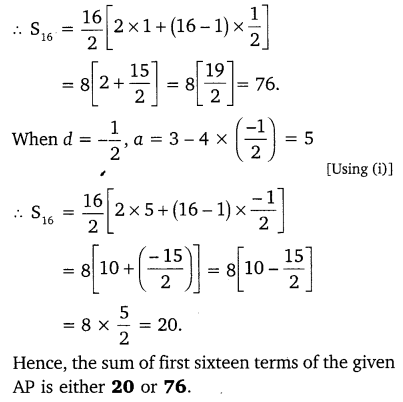
Download NCERT Solutions For Class 10 Maths Chapter 5 Arithmetic Progressions PDF
Ex 5.4 Class 10 Maths Question 3.
A ladder has rungs 25 cm apart. The rungs decrease uniformly in length from 45 cm at the bottom to 25 at the top. If the top and the bottom rungs are 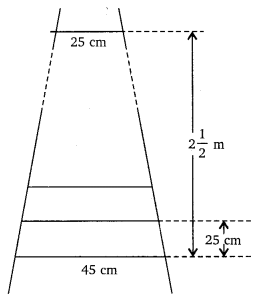
Solution: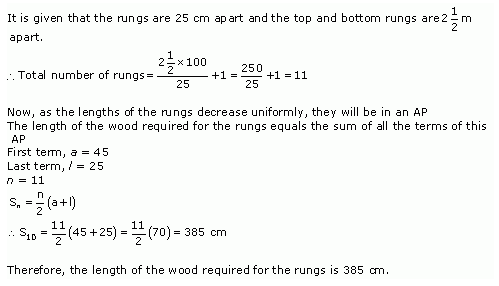
Ex 5.4 Class 10 Maths Question 4.
The houses of a row are numbered consecutively from 1 to 49. Show that there is value of x such that the sum of the numbers of the houses preceding the house numbered x is equal to the sum of the numbers of the houses following it. Find this value of x.
Solution: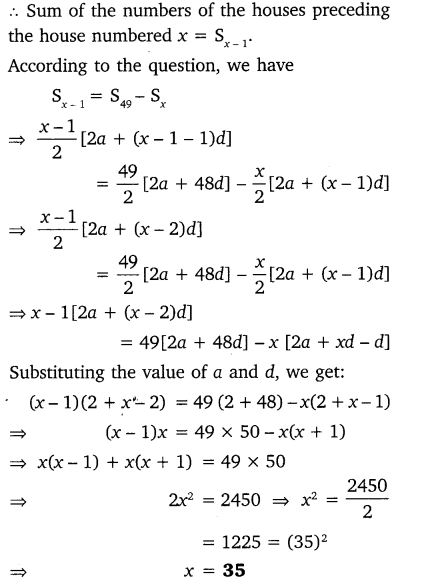
Ex 5.4 Class 10 Maths Question 5.
A small terrace at a football ground comprises of 15 steps each of which is 50 m long and built of solid concrete. Each step has a rise of 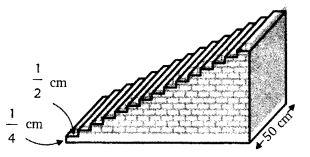
Solution: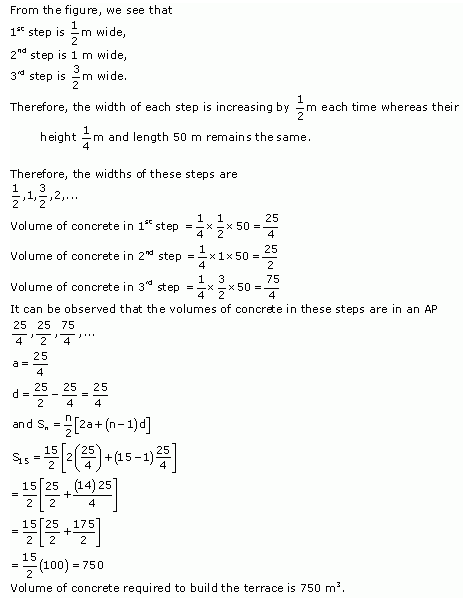
CLASS 10 MATHS CHAPTER 5 EXERCISE 5.4 AP SOLUTIONS IN HINDI
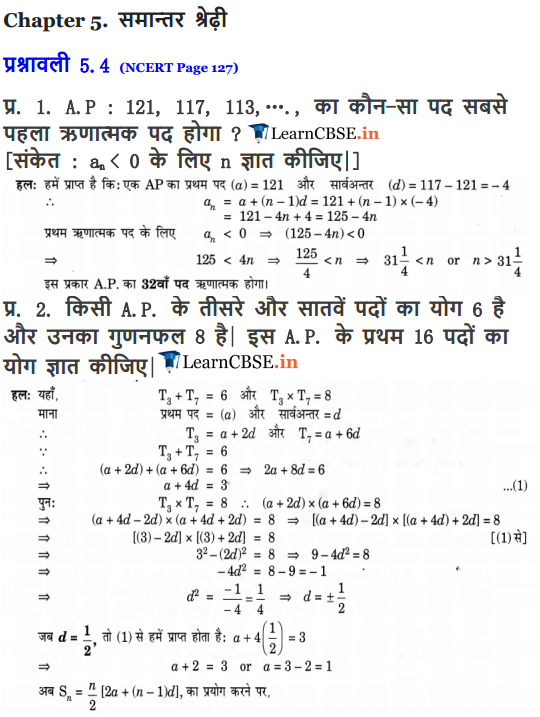
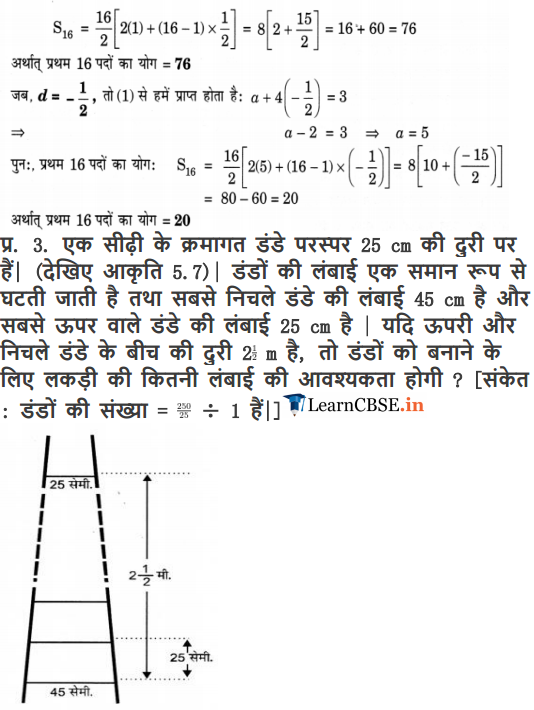
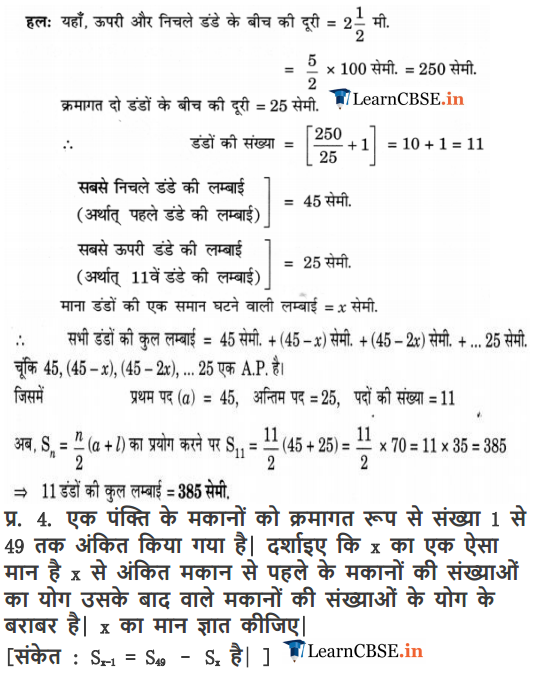
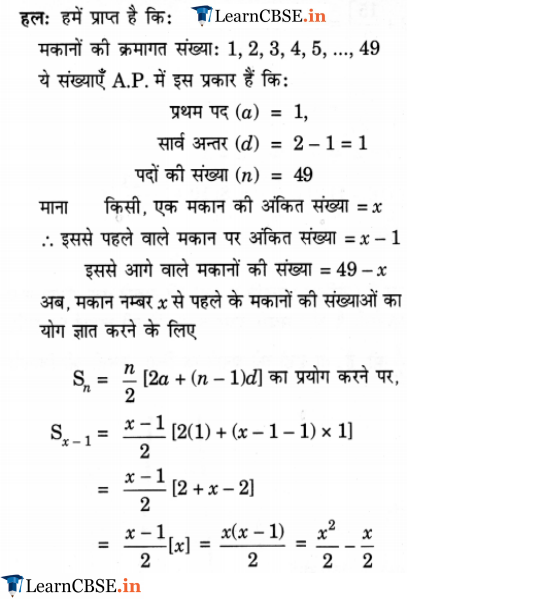
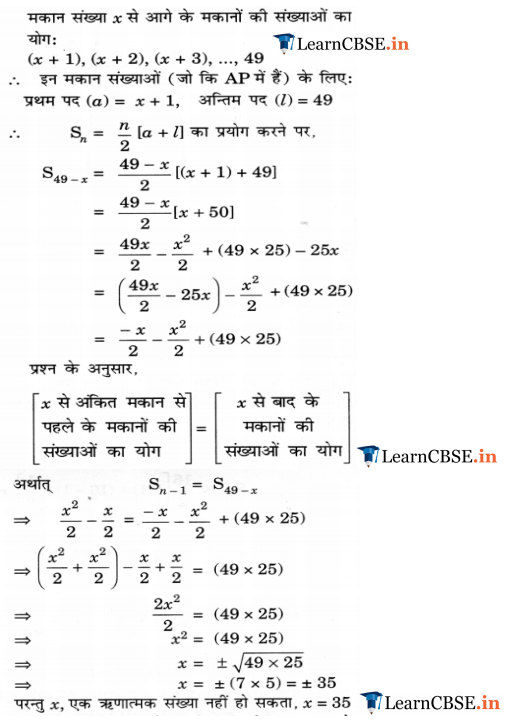
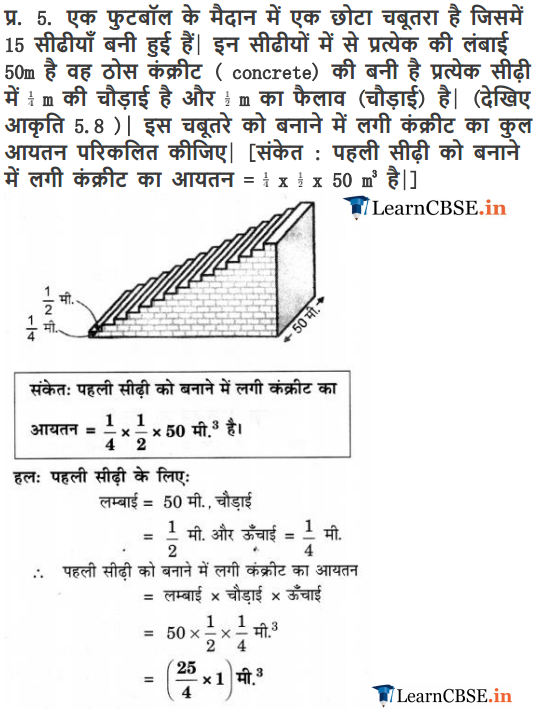
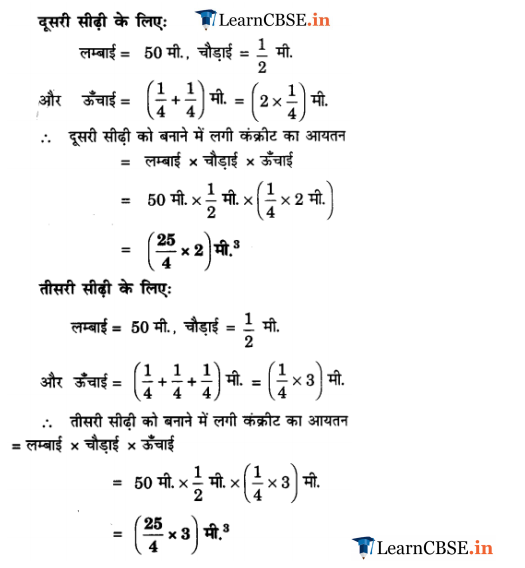
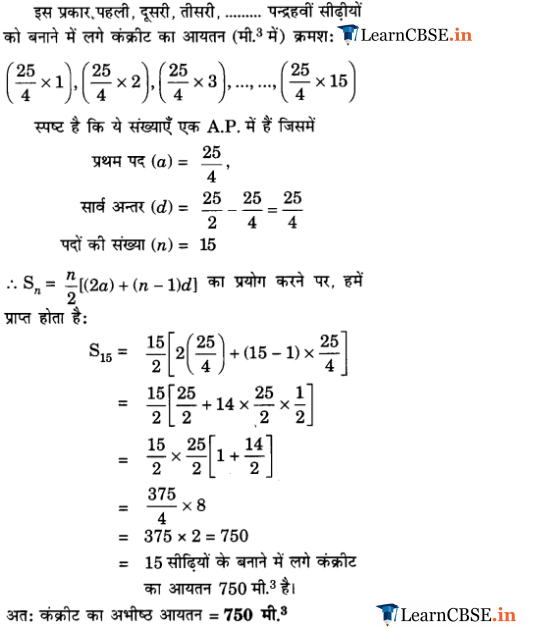
Important Questions for Class 10 Maths Chapter 5 Arithmetic Progressions
Arithmetic Progressions Class 10 Important Questions Very Short Answer (1 Mark)
Question 1.
Find the common difference of the AP
Solution:
The common difference,
Question 2.
Find the common difference of the A.P.
Solution:
The common difference, d = a2 – a1 =
=
Question 3.
Find the common difference of the A.P.
Solution:
Common difference, d = a2 – a1 =
=
Question 4.
Calculate the common difference of the A.P.
Solution:
Common difference, d = a2 – a1=
=
Question 5.
Calculate the common difference of the A.P.
Solution:
Common difference, d = a2 – a1 =
=
Question 6.
What is the common difference of an A.P. in which a21 – a7 = 84? (2017OD )
Solution:
a21 – a7 = 84 …[Given
∴ (a + 20d) – (a + 6d) = 84 …[an = a + (n – 1)d
20d – 6d = 84
14d = 84 ⇒ d
Question 7.
Find the 9th term from the end (towards the first term) of the A.P. 5,9,13, …, 185. (2016D)
Solution:
Here First term, a = 5
Common difference, d = 9 – 5 = 4
Last term, 1 = 185
nth term from the end = l – (n – 1)d
9th term from the end = 185 – (9 – 1)4
= 185 – 8 × 4 = 185 – 32 = 153
Arithmetic Progressions Class 10 Important Questions Short Answer-I (2 Marks)
Question 8.
The angles of a triangle are in A.P., the least being half the greatest. Find the angles. (2011D)
Solution:
Let the angles be a – d, a, a + d; a > 0, d > 0
∵ Sum of angles = 180°
∴ a – d + a + a + d = 180°
⇒ 3a = 180° ∴ a = 60° …(i)
By the given condition
a – d =
⇒ 2 = 2a – 2d = a + d
⇒ 2a – a = d + 2d ⇒ a = 3d
⇒ d =
∴ Angles are: 60° – 20°, 60°, 60° + 20°
i.e., 40°, 60°, 80°
Question 9.
Find whether -150 is a term of the A.P. 17, 12, 7, 2, … ? (2011D)
Solution:
Given: 1st term, a = 17
Common difference, d = 12 – 17 = -5
nth term, an = – 150 (Let)
∴ a + (n – 1) d = – 150
17 + (n – 1)(-5) = – 150
(n – 1) (-5) = – 150 – 17 = – 167
(n − 1) =
n =
n =
∴ -150 is not a term of given A.P.
Question 10.
Which term of the progression 4, 9, 14, 19, … is 109? (2011D)
Solution:
Here, d = 9 -4 = 14 -9 = 19 – 14 = 5
∴ Difference between consecutive terms is constant.
Hence it is an A.P.
Given: First term, a = 4, d = 5, an = 109 (Let)
∴ an = a + (n – 1) d … [General term of A.P.
∴ 109 = 4 + (n – 1) 5
⇒ 109 – 4 = (n – 1) 5
⇒ 105 = 5(n − 1) ⇒ n – 1 =
⇒ n = 21 + 1 = 22 ∴ 109 is the 22nd term
Question 11.
Which term of the progression 20, 192, 183, 17 … is the first negative term? (2017OD)
Solution:
Given: A.P.: 20,
Here a = 20, d =
For first negative term, an < 0
⇒ a + (n − 1)d < 0 ⇒ 20 + (n − 1)(-
⇒ –
⇒ 3n – 3 > 80 ⇒ 3n > 83
n >
∴ Its negative term is 28th term.
Question 12.
The 4th term of an A.P. is zero. Prove that the 25th term of the A.P. is three times its 11thterm. (2016OD)
Solution:
Let 1st term = a, Common difference = d
a4 = 0 a + 3d = 0 ⇒ a = -3d … (i)
To prove: a25 = 3 × a11
a + 24d = 3(a + 10d) …[From (i)
⇒ -3d + 24d = 3(-3d + 10d)
⇒ 21d = 21d
From above, a25 = 3(a11) (Hence proved)
Question 13.
The 7th term of an A.P. is 20 and its 13th term is 32. Find the A.P. (2012OD)
Solution:
Let a be the 1th term and d be the common difference.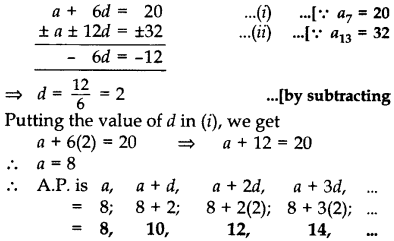
Question 14.
Find 10th term from end of the A.P. 4,9, 14, …, 254. (2011OD)
Solution:
Common difference d = 9 – 4
= 14 – 9 = 5
Given: Last term, l = 254, n = 10
nth term from the end = l – (n – 1) d
∴ 10th term from the end = 254 – (10 – 1) × 5
= 254 – 45 = 209
Question 15.
Find how many two-digit numbers are divisible by 6? (2011OD)
Solution:
12, 18, 24, …,96
Here, a = 12, d = 18 – 12 = 6, an = 96
a + (n – 1)d = an
∴ 12 + (n – 1)6 = 96
⇒ (n − 1)6 = 96 – 12 = 84
⇒ n – 1 =
⇒ n = 14 + 1 = 15
∴ There are 15 two-digit numbers divisible by 6.
Question 16.
How many natural numbers are there between 200 and 500, which are divisible by 7? (2011OD)
Solution:
203, 210, 217, …, 497
Here a = 203, d = 210 – 203 = 7, an = 497
∴ a + (n – 1) d = an
203 + (n – 1) 7 = 497
(n – 1) 7 = 497 – 203 = 294
n – 1 =
∴ There are 43 natural nos. between 200 and 500 which are divisible by 7.
Question 17.
How many two-digit numbers are divisible by 3? (2012OD)
Solution:
Two-digit numbers divisible by 3 are:
12, 15, 18, …, 99
Here, a = 12, d = 15 – 12 = 3, an = 99
∴ a + (n – 1)d = an
12 + (n – 1) (3) = 99
(n – 1) (3) = 99 – 12 = 87
n – 1 =
∴ n = 29 + 1 = 30
∴ There are 30 such numbers.
Question 18.
How many three-digit natural numbers are divisible by 7? (2013D)
Solution:
“3 digits nos.” are 100, 101, 102, …, 999
3 digits nos. “divisible by 7” are:
105, 112, 119, 126, …, 994
a = 105, d = 7, an = 994, n = ?
As a + (n – 1)d = 994 = an
∴ 105 + (n – 1)7 = 994
(n − 1)7 = 994 – 105
(n – 1) =
∴ n = 127 + 1 = 128
Question 19.
Find the number of all three-digit natural numbers which are divisible by 9. (2013OD)
Solution:
To find: Number of terms of A.P., i.e., n.
A.P. = 108 + 117 + 126 + … + 999
1st term, a = 108
Common difference, d = 117 – 108 = 9
an = 999
a + (n – 1)d = an
∴ 108 + (n – 1) 9 = 999
⇒ (n − 1) 9 = 999 – 108 = 891
⇒ (n − 1) =
∴ n = 99 + 1 = 100
Question 20.
Find the number of natural numbers between 101 and 999 which are divisible by both 2 and 5. (2014OD)
Solution:
Numbers divisible by both 2 and 5 are 110, 120, 130, …, 990.
Here a = 110, d = 120 – 110 = 10, an = 990
As a + (n – 1)d = an = 990
110 + (n – 1)(10) = 990
(n – 1)(10) = 990 – 110 = 880
(n − 1) =
∴ n = 88 + 1 = 89
Question 21.
Find the middle term of the A.P. 6, 13, 20, …, 216. (2015D)
Solution:
The given A.P. is 6, 13, 20, …, 216
Let n be the number of terms, d = 7, a = 6, an = 216
an = a + (n – 1)d
∴ 216 = 6 + (n – 1).7
216 – 6 = (n – 1)7
⇒ n = 31
Middle term =
=
∴ a16 = a + 15d = 6 + 15 × 7 = 111
Question 22.
Find the middle term of the A.P. 213, 205, 197, … 37. (2015D)
Solution:
A.P. : 213, 205, 197, …………. 37.
Let a and d be the first term and common difference of A.P. respectively,
Here a = 213, d = -8, an = 37, where n is the number of terms.
an = a + (n – 1)d
∴ 37 = 213 + (n – 1) (-8)
∴ Middle term =
= 12th term
∴ a12 = a + 11(d) = 213 + 11(-8) = 125
Question 23.
How many terms of the A.P. 27, 24, 21, … should be taken so that their sum is zero? (2016D)
Solution:
Here, 1st term, a = 27
Common difference, d = 24 – 27 = -3
Given: Sn = 0
⇒
⇒
⇒ n(54 – 3n + 3) = 0
⇒ n(57 – 3n) = 0
⇒ n = 0 or (57 – 3n) = 0
⇒ -3n = -57
⇒ n = 19
Since n, i.e., number of terms cannot be zero.
∴ Number of terms = 19
Question 24.
How many terms of the A.P. 65, 60, 55, … be taken so that their sum is zero? (2016D)
Solution:
1st term, a = 65
Common difference, d = 60 – 65 = -5
Sn = 0 …[Given
⇒
⇒
⇒ n(130 – 5n + 5) = 0
⇒ n(135 – 5n) = 0
⇒ n = 0 or 135 – 5n = 0
-5n = -135
⇒ n = 27
Since n, i.e., number of terms can not be zero.
∴ Number of terms = 27
Question 25.
Find the sum of the first 25 terms of an A.P. whose nth term is given by tn = 2 – 3n. (2012D)
Solution:
Given: tn = 2 – 3n
When n = 1, t1 = 2 – 3(1) = -1 ..(i)
When n = 25, t25 = 2 – 3(25) = -73 …(ii)
As Sn =
∴ S25 =
=
Question 26.
The first and the last terms of an AP are 5 and 45 respectively. If the sum of all its terms is 400, find its common difference. (2014D)
Solution:
Here, an = 45, Sn = 400, a = 5, n = ?, d = ?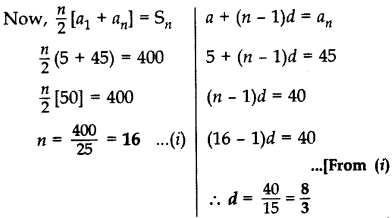
Question 27.
The first and the last terms of an AP are 8 and 65 respectively. If the sum of all its terms is 730, find its common difference. (2014D)
Solution:
Here a, = a = 8; an = 65
Given: Sn = 730
⇒
n = 730 ×
Now, an = a + (n − 1)d = 65
8 +(20 – 1)d = 65 ⇒ 19d = 65 – 8 = 57
∴ d = 3
Question 28.
In an AP, if S5 + S7 = 167 and S10 = 235, then find the AP, where s, denotes the sum of its first n terms. (2015OD)
Solution:
Given: S5 + S7 = 167
⇒
⇒
⇒ 5(a + 2d) + 7(a + 3d) = 167
⇒ 5a + 10d + 7a + 210 = 167
⇒ 12a + 31d = 167
Now, S10 =
⇒ 5[2a + 9d] = 235
⇒ 10a + 45d = 235
Solving (i) and (ii), we get a = 1 and d = 5
a1 = 1
a2 = a + d ⇒ 1 + 5 = 6
a3 = a + 2d ⇒ 1 + 10 = 11
Hence A.P. is 1, 6, 11…
Question 29.
Find the sum of all three digit natural numbers, which are multiples of 11. (2012D)
Solution:
To find: 110 + 121 + 132 + … + 990
Here a = 110, d = 121- 110 = 11, an = 990
∴ a + (n – 1)d = 990
110 + (n – 1).11 = 990
(n – 1). 11 = 990 – 110 = 880
(n – 1) = 880 = 80
n = 80 + 1 = 81
As Sn =
∴ S81 =
=
Arithmetic Progressions Class 10 Important Questions Short Answer – II (3 Marks)
Question 30.
Which term of the A.P. 3, 14, 25, 36, … will be 99 more than its 25th term? (2011OD)
Solution:
Let the required term be nth term, i.e., an
Here, d = 14 – 3 = 11, a = 3
According to the Question, an = 99 + a25
∴ a + (n – 1) d = 99 + a + 24d
⇒ (n – 1) (11) = 99 + 24 (11)
(n – 1) (11) = 11 (9 + 24)
n – 1 = 33
n = 33 + 1 = 34
∴ 34th term is 99 more than its 25th term.
Question 31.
Determine the A.P. whose fourth term is 18 and the difference of the ninth term from the fifteenth term is 30. (2011D)
Solution:

Question 32.
The 19th term of an AP is equal to three times its 6th term. If its 9th term is 19, find the A.P. (2013OD)
Solution:
Given: a19 = 3(a6)
⇒ a + 18d = 3(a + 5d)
a + 18d = 3a + 15d
18d – 15d = 3a – a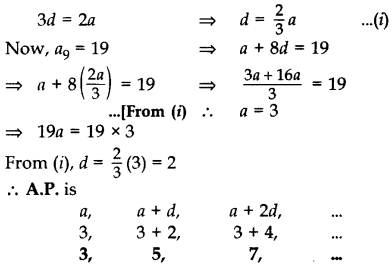
Question 33.
The 9th term of an A.P. is equal to 6 times its second term. If its 5th term is 22, find the A.P. (2013OD)
Solution:
9th term = 6 (2nd term)
∴ a +8d = 6 (a + d) …[As an = a + (n – 1)d
a + 8d = 6a + 6d
8d – 6d = 6a – a
2d = 5a
⇒ d =
Now, a5 = 22
a + 4d = 22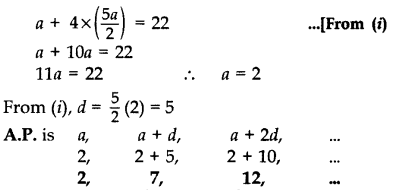
Question 34.
The sum of the 5th and the 9th terms of an AP is 30. If its 25th term is three times its 8th term, find the AP. (2014OD)
Solution:
a5 + a9 = 30 … [Given
a + 4d + a + 8d = 30 …[∵ an = a + (n – 1)d
2a + 12d = 30 ⇒ a + 6d = 15 …[Dividing by 2
a = 15 – 6d …(i)
Now, a52 = 3(a8)
a + 24d = 3(a + 7d)
15 – 6d + 240 = 3(15 – 6d + 7d) …[From (i)
15 + 18d = 3(15 + d)
15 + 18d = 45 + 3d
18d – 3d = 45 – 15
15d = 30 ∴ d =
From (i), a = 15 – 6(2) = 15 – 12 = 3
Question 35.
If the seventh term of an AP is
Solution: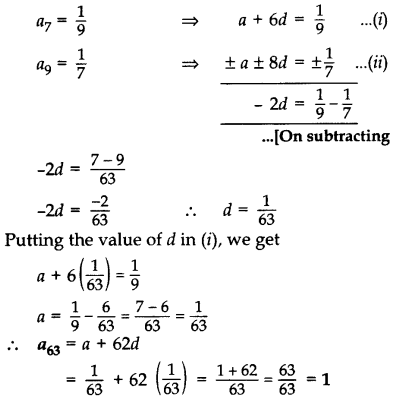
Question 36.
Find the value of the middle term of the following A.P.: -6, -2, 2, …, 58. (2011D)
Solution:
Here a = -6, d = -2 -(-6) = 4, an = 58
As we know, a + (n – 1) d = 58
∴ -6 + (n – 1) 4 = 58
⇒ (n – 1) 4 = 58 + 6 = 64
⇒ (n – 1) =
⇒ n = 16 + 1 = 17 (odd)
Middle term =
∴ a9 = a + 8d = -6 + 8 (4) = -6 + 32 = 26
∴ Middle term = 26
Question 37.
Find the number of terms of the AP 18, 151/2, 13,…, -491/2 and find the sum of all its terms.
Solution:
Here 1st term, a = 18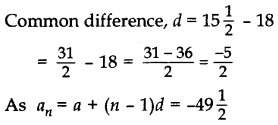
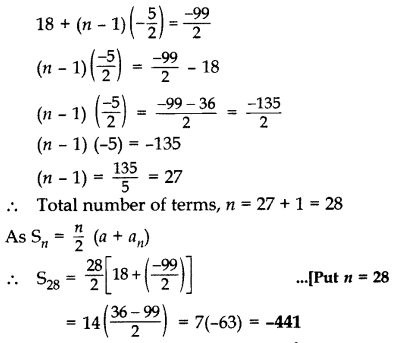
Question 38.
The 14th term of an AP is twice its gth term. If its 6th term is -8, then find the sum of its first 20 terms. (2015OD)
Solution:
Let a = First term, d = Common difference
a14 = 2.a8 … [Given
⇒ a + 13d = 2 (a + 7d) ..[∵ a, = a + (n – 1)d
⇒ a + 13d = 2a + 14d
⇒ 1a – 2a = 14d – 13d
⇒ -1a = d ⇒ a = -d … (i)
a6 = -8 …[Given
⇒ -8 = a + 5d
⇒ -d + 5d = -8 …[From (i)
⇒ 4d = -8 ⇒ d = -2
Value of d put in equation (i), we get
a = -d ⇒ a=-(-2)
Now, a = 2, d = -2
Now, Sum of first 20 terms,
S20 =
S20 = 10[4 + 19(-2)]
S20 = 10[4 – 38] = -340
Question 39.
The 13th term of an AP is four times its 3rd term. If its fifth term is 16, then find the sum of its first ten terms. (2015OD)
Solution:
a13 = 4a3 … [Given
⇒ a + 12d = 4(a + 2d) …[∵ an = a + (n – 1)d
⇒ a + 12d – 4a – 8d = 0
⇒ 4d = 3a ⇒ d =
a5 = 16 … [Given
⇒ a + 4d = 16
⇒ a +4(
⇒ a + 3a = 16
⇒ 4a = 16 ⇒ a =
Putting a = 4 in (i), we get a = 3
⇒ d =
∴ Sn =
S10 =
S10 = 5 (8 + 27) ⇒ 5(35) = 175
Question 40.
If the sum of first 7 terms of an A.P is 49 and that of its first 17 terms is 289, find the sum of first n terms of the A.P. (2016D)
Solution:
Let 1st term = a, Common difference = d
Given: S7 = 49, S17 = 289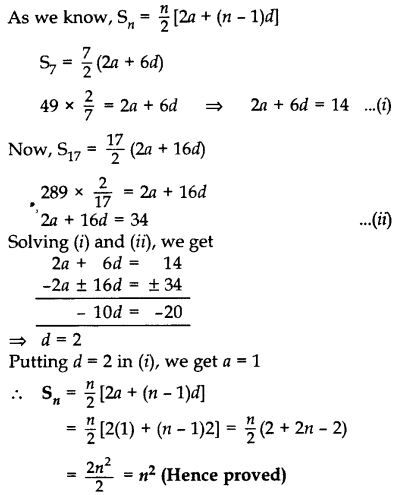
Question 41.
The first term of an A.P. is 5, the last term is 45 and the sum of all its terms is 400. Find the number of terms and the common difference of the A.P. (2017OD)
Solution:
First term, a = 5, Last term, an = 45
Let the number of terms = n
Sn = 400
n =
Now, an = 45
a + (n – 1)d = an
5+ (16 – 1)d = 45
15d = 45 – 5 ∴ d =
Question 42.
The nth term of an A.P. is given by (-4n + 15). Find the sum of first 20 terms of this A.P. (2013D)
Solution:
We have, an = -4n + 15
Put n = 1, a1 = -4(1) + 15 = 11
Put n=2, a2 = -4(2) + 15 = 7
∴ d = a2 – a1 = 7 – 11 = -4
As Sn =
∴ S20 =
= 10 (22 – 76)
= 10 (-54) = -540
Question 43.
The sum of first n terms of an AP is 3n2 + 4n. Find the 25th term of this AP. (2013D)
Solution:
We have, Sn = 3n2 + 4n
Put n = 25,
S25 = 3(25)2 + 4(25)
= 3(625) + 100
= 1875 + 100 = 1975
Put n = 24,
S24 = 3(24)2 + 4(24)
= 3(576) + 96
= 1728 + 96 = 1824
∴ 25th term = S25 – S24
= 1975 – 1824 = 151
Question 44.
The sum of the first seven terms of an AP is 182. If its 4th and the 17th terms are in the ratio 1 : 5, find the AP. (2014OD)
Solution:
S7 = 182 …[Given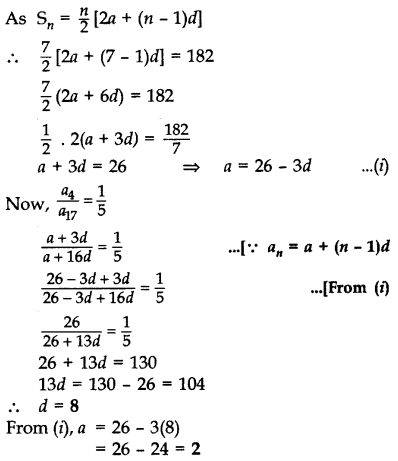
∴ a = 2, d = 8
∴AP is 2, 10, 18, 26, 34, …
Question 45.
If Sn, denotes the sum of first n terms of an A.P., prove that S12 = 3(S8 – S4). (2015D)
Solution:
Let a be the first term and d be the common difference of A.P.
Sn =
∴ S12 =
S12 = 6 [2a + 11d] = 124 + 66d …(i)
∴ S8 =
S8 = 4[2a + 7d] = 8a + 28d … (ii)
∴ S4 =
S4 = 2[2a + 3d) = 4a + 6d …(iii)
Now, S12 = 3(S8 – S4)
12a + 660 = 3(8a + 28d – 4a – 6d) … [From (i), (ii) & (iii)
12a + 660 = 3(4a + 22d)
12a + 660 = 12a + 66d …Hence proved
Question 46.
If the sum of the first n terms of an A.P. is
Solution:
Sn =
Put n = 1
S1 =
Put n = 2
S2 =
= S2 =
Now we know,
S1 = 27 and a2 = S2 – S1
∴ a1 = 5 = 13 – 5 = 8
Now we have,
a1 = 5, a2 = 8, d = a2 – a1 = 8 – 5 = 3
an = a + (n – 1)d = 5 + (n – 1)3
= 5 + 3n – 3 = 3n + 2 (nth term)
∴ 20th term, a20 = (3 × 20) + 2 = 62
Question 47.
If Sn denotes the sum of first n terms of an A.P., prove that S30 = 3[S20 – S10]. (2015D)
Solution:
Let a be the first term and d be the common difference of the A.P.
Sn =
S30 =
= 30a + 435d …(i)
S20 =
= 20a + 190d …(ii)
S10 =
= 10a + 45d …(iii)
To prove, 3(S20 – S10) = S30
= 3(20a + 190d – 10a – 45d) …[From (i), (ii) & (iii)
= 3(10a + 145d)
= 30a + 435d = S30 …Hence Proved
Question 48.
If the ratio of the sum of first n terms of two A.Ps is (7n + 1): (4n + 27), find the ratio of their mth terms. (2016OD)
Solution:
Let A be first term and D be the common difference of 1st A.P.
Let a be the first term and d be the common difference of 2nd A.P.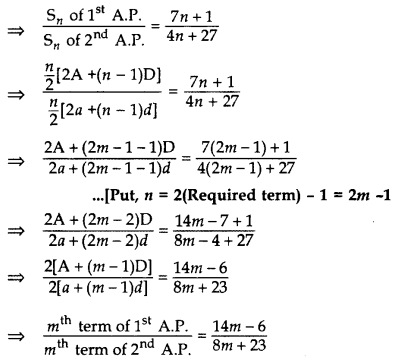
∴ Required ratio = (14m – 6) : (8m + 23)
Question 49.
The digits of a positive number of three digits are in A.P. and their sum is 15. The number obtained by reversing the digits is 594 less than the original number. Find the number. (2016OD)
Solution:
Let hundred’s place digit = (a – d)
Let ten’s place digit = a
Let unit’s place digit = a + d
According to the Question,
a – d + a + a + d = 15
⇒ 3a = 15 ⇒ a = 5
Original number
= 100(a – d) + 10(a) + 1(a + d)
= 100a – 100d + 10a + a + d
= 111a – 99d
Reversed number
= 1(a – d) + 10a + 100(a + d)
= a – d + 10a + 100a + 100d
= 111a + 99d
Now, Original no. – Reversed no. = 594
111a – 99d – (111a + 99d) = 594
-198d = 594 ⇒ d =
∴ The Original no. = 111a – 99d
= 111(5) – 99(-3)
= 555 + 297 = 852
Question 50.
The sums of first n terms of three arithmetic progressions are S1 S2 and S3 respectively. The first term of each A.P. is 1 and their common differences are 1, 2 and 3 respectively. Prove that S1 + S3 = 2S2. (2016OD)
Solution: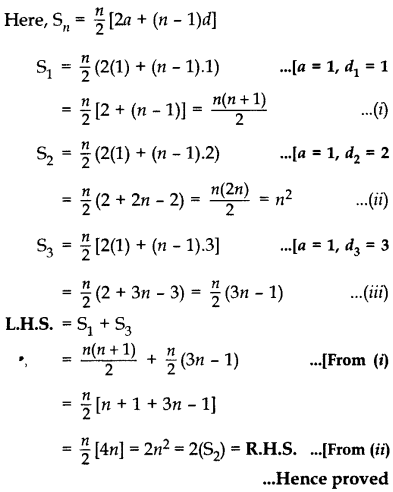
Question 51.
Find the sum of all three digit natural numbers, which are multiples of 9. (2012D)
Solution:
To find: 108 + 117 + 126 + … + 999
1st term, a = 108
Common difference, d = 117 – 108 = 9
∴ a + (n – 1)d = an = 999
108 + (n – 1). 9 = 999
(n – 1)9 = 999 – 108 = 891
(n – 1) =
n = 99 + 1 = 100
As Sn=
∴ S100 =
= 50(1107) = 55350
Question 52.
Find the sum of all multiples of 7 lying between 500 and 900. (2012OD)
Solution:
To find: 504 + 511 + 518 + … + 896
a = 504, d = 511- 504 = 7, an = 896
a + (n – 1)d = an
∴ 504 + (n – 1)7 = 896
(n – 1)7 = 896 – 504 = 392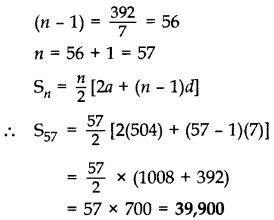
Arithmetic Progressions Class 10 Important Questions Long Answer (4 Marks)
Question 53.
If pth, qth and rth terms of an A.P. are a, b, c respectively, then show that (a – b)r + (b – c)p+ (c – a)q = 0. (2011D)
Solution:
Let A be the first term and D be the common difference of the given A.P.
pth term = A + (p – 1)D = a …(i)
qth term = A + (q – 1)D = b …(ii)
rth term = A + (r – 1)D = c … (iii)
L.H.S. = (a – b)r + (b – c)p + (c – a)q
= [A + (p – 1)D – (A + (q – 1)D)]r + [A + (q – 1)D – (A + (r – 1)D)]p + [A + (r – 1)D – (A + (p – 1)D)]q
= [(p – 1 – q + 1)D]r + [(q – 1 – r + 1)D]p + [(r – 1 – p + 1)D]q
= D[(p – q)r + (q – r)p + (r – p)q]
= D[pr – qr + qp – rp + rq – pq]
= D[0] = 0 = R.H.S.
Question 54.
The 17th term of an AP is 5 more than twice its 8th term. If the 11th term of the AP is 43, then find its nth term. (2012D)
Solution: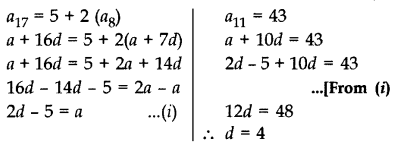
From (i),
a = 2(4) – 5 = 8 – 5 = 3
As an = a + (n – 1) d
∴ an = 3 + (n – 1) 4 = 3 + 4n – 4
an = (4n – 1)
Question 55.
The 15th term of an AP is 3 more than twice its 7th term. If the 10th term of the AP is 41, then find its nth term. (2012D)
Solution: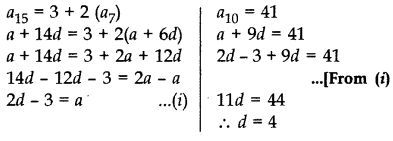
From (i),
a = 2(4) – 3
= 8 – 3 = 5
nth term = a + (n – 1) d
∴ nth term = 5 + (n – 1) 4
= 5 + 4n – 4 = (4n + 1)
Question 56.
The 16th term of an AP is 1 more than twice its 8th term. If the 12th term of the AP is 47, then find its nth term. (2012D)
Solution: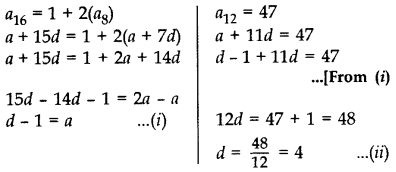
From (i) and (ii), a = 4 – 1 = 3
As nth term = a + (n – 1) d
∴ nth term = 3 + (n – 1) 4
= 3 + 4n -4 = 4n -1
Question 57.
A sum of ₹1,600 is to be used to give ten cash prizes to students of a school for their overall academic performance. If each prize is ₹20 less than its preceding prize, find the value of each of the prizes. (2012OD)
Solution:
Here S10 = 1600, d = -20, n = 10
Sn =
∴
2a – 180 = 320
2a = 320 + 180 = 500
a = 250
∴ 1st prize = a = ₹250
2nd prize = a2 = a + d = 250 + (-20) = ₹230
3rd prize = a3 = a2 + d = 230 – 20 = ₹210
4th prize = a4 = a3 + d = 210 – 20 = ₹190
5th prize = a5 = a4 + d = 190 – 20 = ₹170
6th prize = a6 = a5 + d = 170 – 20 = ₹150
7th prize = a7 = a6 + d = 150 – 20 = ₹130
8th prize = a8 = a7 + d = 130 – 20 = ₹110
9th prize = a9 = a8 + d = 110 – 20 = ₹590
10th prize = a10 = a9 + d = 90 – 20 = ₹70
= ₹ 1,600
Question 58.
Find the 60th term of the AP 8, 10, 12, …, if it has a total of 60 terms and hence find the sum of its last 10 terms. (2015OD)
Solution:
a = 8, d = a2 – a1 = 10 – 8 = 2, n = 60
a60 = a + 59d = 8 + 59(2) = 126
∴ Sum of its last 10 terms = S60 – S50
=
=
= 30 (8 + 126) – 25 (16 + 98)
= 4020 – 25 × 114
= 4020 – 2850 = 1170
Question 59.
An Arithmetic Progression 5, 12, 19, … has 50 terms. Find its last term. Hence find the sum of its last 15 terms. (2015OD)
Solution:
Let a and d be the first term and common difference of A.P. respectively,
a = 5, d = 12 – 5 = 7, n = 50
∴ an = a + (n – 1)d
a50 = 5 + 49(7) = 5 + 343 = 348
∴ Sum of its last 15 terms = S50 – S35
=
=
= 25(353) –
= 8825 – 35 × 124
= 8825 – 4340 = 4485
Question 60.
If the sum of first 4 terms of an A.P. is 40 and that of first 14 terms is 280, find the sum of its first n terms. (2011D)
Solution:
Sn = 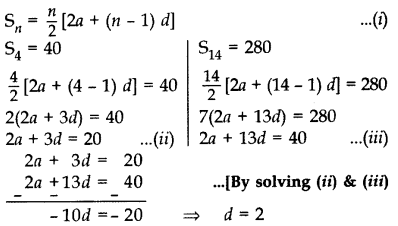
Putting the value of d = 2 in (ii), we get a = 7
∴ Sn =
=
= n (n + 6) or n2 + 6n
Question 61.
The first and the last terms of an A.P. are 8 and 350 respectively. If its common difference is 9, how many terms are there and what is their sum? (2011D)
Solution:
Here a = 8, an = 350, d = 9
As we know, a + (n − 1) d = a2
∴ 8 + (n – 1) 9 = 350
(n − 1) 9 = 350 – 8 = 342
n – 1 =
n = 38 + 1 = 39
∴ There are 39 terms.
∴ Sn =
∴ S39 =
= 39 × 179 = 6981
Question 62.
Sum of the first 20 terms of an AP is -240, and its first term is 7. Find its 24th term. (2012D)
Solution:
Given: a = 7, S20 = -240
Here, Sn =
∴ S20 =
-240 = 10(14 + 19d)
–
19d = -24 – 14 = -38
⇒ d =
Again, an = a + (n – 1)d
∴ a24 = 7 + (24 – 1) (-2) … [From (i)
= 7 – 46 = -39
Question 63.
Find the common difference of an A.P. whose first term is 5 and the sum of its first four terms is half the sum of the next four terms. (2012OD)
Solution:
Here a = 5 … (i)
Here, a1 + a2 + a3 + a4 =
∴ a + (a + d) + (a + 2d) + (a + 3d)
=
∴ 4a + 6d =
8a + 12d = 4a + 22d
8a – 4a = 22d – 12d
4a = 100 ⇒ 4(5) = 10d
d =
∴ Common difference, d = 2
Question 64.
If the sum of the first 7 terms of an A.P. is 119 and that of the first 17 terms is 714, find the sum of its first n terms. (2012OD)
Solution:
As Sn = 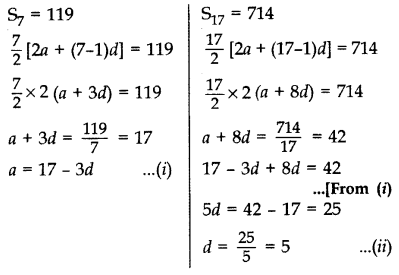
S2 = 119
From (i) and (ii), a = 17 – 3(5) = 17 – 15 = 2
∴Sn =
=
=
Question 65.
The 24th term of an AP is twice its 10th term. Show that its 72nd term is 4 times its 15th term. (2013D)
Solution:
a24 = 2 (10) … [Given
a + 23d = 2 (a +9d) [∵ an = a + (n – 1)d)
23d = 2a + 18d – a
23d – 18d = a ⇒ a = 5d …(i)
To prove: a72 = 4 (a15)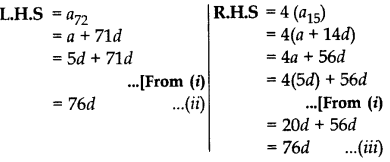
From (ii) and (iii), L.H.S = R.H.S …Hence Proved
Question 66.
Find the number of terms of the A.P. -12, -9, – 6, …, 21. If 1 is added to each term of this A.P., then find the sum of all terms of the A.P. thus obtained. (2013D)
Solution:
Here a = -12, d=-9 + 12 = 3
Here, an = a + (n – 1)d = 21
∴ -12 + (n – 1).3 = 21
(n – 1).3 = 21 + 12 = 33
∴ n – 1 = 11
Total number of terms,
n = 11 + 1 = 12
New A.P. is![]()
Here 1st term, a = -11
Common difference, d = -8 + 11 = 3;
Last term, an = 22; Number of terms, n= 12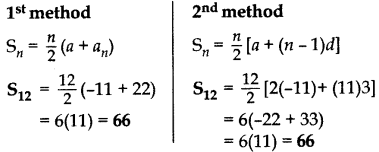
Question 67.
In an AP of 50 terms, the sum of first 10 terms is 210 and the sum of its last 15 terms is 2565. Find the AP. (2014D)
Solution:
Here, n = 50,
Here, S10 = 210
=
5(2a + 9d) = 210
2a + 9d =
⇒ 2a = 42 – 9d ⇒ a =
Now, 50 = (1 + 2 + 3 + …) + (36 + 37 + … + 50) Sum = 2565
Sum of its last 15 terms = 2565 …[Given
S50 – S35 = 2565
100a + 2450d – 70a – 1190d = 2565 × 2
30a + 1260d = 5130
3a + 1260 = 513 …[Dividing both sides by 10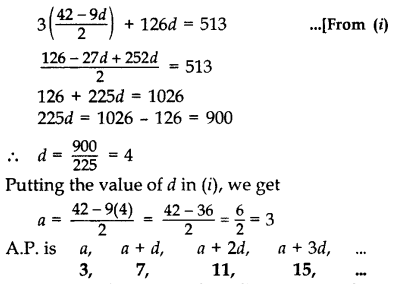
Question 68.
If the ratio of the sum of the first n terms of two A.Ps is (7n + 1): (4n + 27), then find the ratio of their 9th terms. (2017OD)
Solution: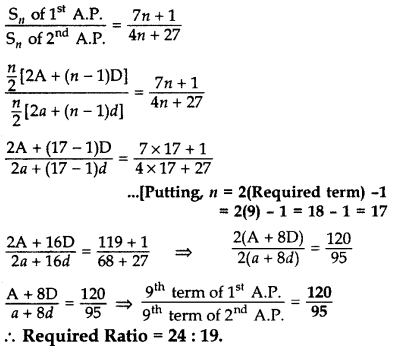
Question 69.
In a school, students decided to plant trees in and around the school to reduce air pollution. It was decided that the number of trees, that each section of each class will plant, will be double of the class in which they are studying. If there are 1 to 12 classes in the school and each class has two Sections, find how many trees were planted by the students. (2014OD)
Solution:
Classes: 1 + I + II + … + XII
Sections: 2(I) + 2(II) + 2(III) + … + 2(XII)
Total no. of trees
= 2 + 4 + 6 … + 24
= (2 × 2) + (2 × 4) + (2 × 6) + … + (2 × 24)
= 4 + 8 + 12 + … + 48
:: S12 =
Question 70.
Ramkali required ₹500 after 12 weeks to send her daughter to school. She saved ₹100 in the first week and increased her weekly saving by ₹20 every week. Find whether she will be able to send her daughter to school after 12 weeks. (2015D)
Solution:
Money required by Ramkali for admission of her daughter = ₹2500
A.P. formed by saving
100, 120, 140, … upto 12 terms ….(i)
Let, a, d and n be the first term, common difference and number of terms respectively. Here, a = 100, d = 20, n = 12
Sn =
⇒ S12 =
S12 =
Question 71.
The sum of first n terms of an A.P. is 5n2 + 3n. If its mth term is 168, find the value of m. Also find the 20th term of this A.P. (2013D)
Solution: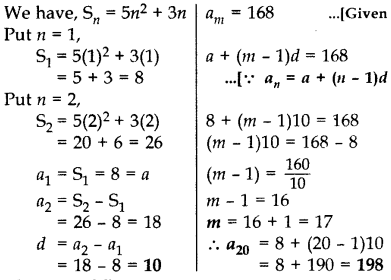
Question 72.
The sum of first m terms of an AP is 4m2 – m. If its nth term is 107, find the value of n. Also find the 21st term of this A.P. (2013D)
Solution:
We have, Sm = 4m2 – m
Put m = 1,
S1 = 4(1)2 – (1)
= 4 – 1 = 3
Put m = 2,
S2 = 4(2)2 – 2
= 16 – 2 = 14
∴ a1 = S1 = 3 = a
a2 = S2 – S1 = 14 – 3 = 11
d = a2 – a1
d = 11 – 3 = 8
an = a + (n – 1)d = 107 …[Given
∴ 3+ (n – 1)8 = 107
(n – 1)8 = 107 – 3 = 104
(n – 1) =
n = 13 + 1 = 14
∴ a21 = a + 20d
= 3 + (20)8
= 3 + 160 = 163
Question 73.
The sum of first g terms of an A.P. is 63q – 3q2. If its pth term is -60, find the value of p. Also find the 11th term of this A.P. (2013D)
Solution:
We have, Sq = 63q – 3q2
Put q = 1,
S7 = 63(1) – 3(1)2
= 63 – 3 = 60
Put q = 2,
S2 = 63(2) – 3(2)2
= 126 – 12 = 114
∴ a = a1 = S1 = 60
a2 = S2 – S71 = 114 – 60 = 54
d = a2 – a1 = 54 – 60 = -6
pth term = -60
a + (p – 1)d = -60
60 + (p – 1)(-6) = -60
(p – 1)(-6) = -60 – 60 = -120
(p – 1) =
p= 20 + 1 = 21
∴ a11 = a + 10d
= 60 + 10(-6)
= 60 – 60 = 0
Question 74.
Find the sum of the first 30 positive integers divisible by 6. (2011D)
Solution:
To find: 6 + 12 + 18 + … (30 terms)
Here a = 6, d = 12 – 6 = 6, n = 30
Sn = [2a + (n − 1) d]
∴ S30 =
= 15 [12 + 29(6)]
= 15 (12 + 174)
= 15 (186) = 2790
Question 75.
How many multiples of 4 lie between 10 and 250? Also find their sum. (2011D)
Solution:
Multiples of 4 between 10 and 250 are:
12, 16, 20, ……… 248
Here, a = 12, d = 4, an = 248
As we know, a + (n – 1) d = an
∴12 + (n – 1) 4 = 248
⇒ (n – 1) 4 = 248 – 12 = 236
n – 1 =
⇒ n = 59 + 1 = 60
∴ There are 60 terms.
Now, Sn =
∴ S60 =
= 30 (260) = 7800
Question 76.
Find the sum of all multiples of 8 lying between 201 and 950. (2012OD)
Solution:
To find: 208 + 216 +224 + … + 944
Here, a = 208, d = 216 – 208 = 8, an = 944
a + (n – 1)d = an
∴ 208 + (n – 1)8 = 944
(n – 1)8 = 944 – 208 = 736
n – 1 =
8 n = 92 + 1 = 93
Now, Sn =
:: S93 =
=
Question 77.
Find the sum of all multiples of 9 lying between 400 and 800. (2012OD)
Solution:
To find: 405 + 414 + 423 + … +792
Here a = 405, d = 414 – 405 = 9, an = 792
a + (n – 1)d = an
∴ 405 + (n – 1)9 = 792
(n – 1)9 = 792 – 405 = 387
n – 1 =
∴ n = 43 + 1 = 44
As Sn =
∴ S44 =
= 22 × 1197 = 26334
Question 78.
A thief runs with a uniform speed of 100 m/minute. After one minute a policeman runs after the thief to catch him. He goes with a speed of 100 m/minute in the first minute and increases his speed by 10 m/minute every succeeding minute. After how many minutes the policeman will catch the thief. (2016D)
Solution:
Let total time ben minutes. Total distance covered by thief in n minutes
= Speed × Time
= 100 × n = 100 n metres
Total distance covered by policeman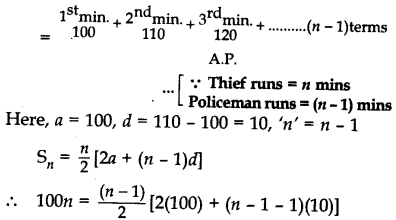
⇒ (n – 1) (200 + 10n – 20) = 200n
⇒ (n – 1) [10n + 180) = 200n
⇒ 10n2 + 180n – 10n – 180 – 200n = 0
⇒ 10n2 – 30n – 180 = 0
⇒ n2 – 3n – 18 = 0 … [Dividing both sides by 10
⇒ n2 – 6n + 3n – 18 = 0
⇒ n(n – 6) + 3(n – 6) = 0
⇒ (n + 3) (n – 6) = 0
⇒ n + 3 = 0 or n – 6 = 0
⇒ n = -3 or n = 6
But n (time) can not be negative.
∴ Time taken by policeman to catch the thief
= n – 1 = 6 – 1 = 5 minutes
Question 79.
A thief, after committing a theft, runs at a uniform speed of 50 m/minute. After 2 minutes, a policeman runs to catch him. He goes 60 m in first minute and increases his speed by 5 m/ minute every succeeding minute. After how many minutes, the policeman will catch the thief? (2016D)
Solution:
Let total time be n minutes.
Total distance covered by thief in n minutes
= Speed × Time
= (50 × n) metres = 50 n metres
Total distance covered by policeman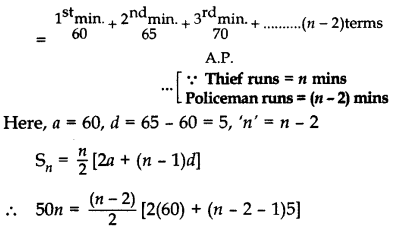
⇒ (n – 2) (120 + 5n – 15) = 100n
⇒ (n – 2) [5n + 105) = 100n
⇒ 5n2 + 105n – 10n – 210 – 100n = 0
⇒ 5n2 – 5n – 210 = 0
⇒ n2 – n – 42 = 0 …[Dividing both sides by 5
⇒ n2 – 7n + 6n – 42 = 0
⇒ n(n – 7) + 6(n – 7) = 0
⇒ (n – 7) (n + 6) = 0
⇒ n – 7 = 0 or n + 6 = 0
⇒ n = 7 or n = -6 (reject)
But n (time) can not be negative.
∴ Time taken by policeman to catch the thief
= n – 2 = 7 – 2 = 5 minutes
Question 80.
The houses in a row are numbered conse cutively from 1 to 49. Show that there exists a value of X such that sum of numbers of houses preceding the house numbered X is equal to sum of the numbers of houses following X. (2016OD)
Solution:
Here the A.P. is 1, 2, 3, …., 49
Here a = 1, d = 1, an = 49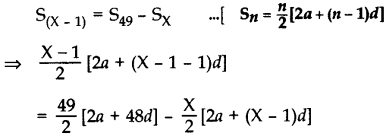
Now,
⇒ (X – 1)2 (2 + (X – 2)) = 49(2 + 48) – X[2 + (x – 1)]
⇒ (X – 1). X = 2,450 – X(X + 1)
⇒ x2 – X = 2,450 – X2 – X
⇒ X2 – X + X2 + X = 2,450
⇒ 2X2 = 2,450
⇒ X2 = 1,225
∴ X =
Question 81.
Find the sum of n terms of the series
Solution:
First term, a = 4 – 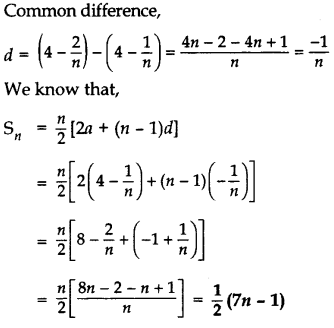
Class 10 Maths Notes Chapter 5 Arithmetic Progressions
SEQUENCE:
A sequence is an arrangement of numbers in a definite order and according to some rule.
Example: 1, 3, 5,7,9, … is a sequence where each successive item is 2 greater than the preceding term and 1, 4, 9, 16, 25, … is a sequence where each term is the square of successive natural numbers.
TERMS :
The various numbers occurring in a sequence are called ‘terms’. Since the order of a sequence is fixed, therefore the terms are known by the position they occupy in the sequence.
Example: If the sequence is defined as
ARITHMETIC PROGRESSION (A.P.):
An Arithmetic progression is a special case of a sequence, where the difference between a term and its preceding term is always constant, known as common difference, i.e., d. The arithmetic progression is abbreviated as A.P.
The general form of an A.P. is
∴ a, a + d, a + 2d,… For example, 1, 9, 11, 13.., Here the common difference is 2. Hence it is an A.P.
In an A.P. with first term a and common difference d, the nth term (or the general term) is given
by .
an = a + (n – 1)d.
…where [a = first term, d = common difference, n = term number
Example: To find seventh term put n = 7
∴ a7 = a + (7 – 1)d or a7 = a + 6d
The sum of the first n terms of an A.P. is given by
Sn =
where, 1 is the last term of the finite AP.
If a, b, c are in A.P. then b =
Here Is The Class 10 Maths All NCERT Solutions In Hindi + English With Extra Questions, Notes And Important Questions
- Chapter 1 Real Numbers
- Chapter 2 Polynomials
- Chapter 3 Pair of Linear Equations in Two Variables
- Chapter 4 Quadratic Equations
- Chapter 5 Arithmetic Progressions
- Chapter 6 Triangles
- Chapter 7 Coordinate Geometry
- Chapter 8 Introduction to Trigonometry
- Chapter 9 Applications of Trigonometry
- Chapter 10 Circle
- Chapter 11 Constructions
- Chapter 12 Areas related to Circles
- Chapter 13 Surface Areas and Volumes
- Chapter 14 Statistics
- Chapter 15 Probability
.png)
.png)